

Are Leopard Catamarans Good? A Complete Review
As an Amazon Associate, we earn from qualifying purchases. We may also earn commissions if you purchase products from other retailers after clicking on a link from our site.
Catamarans are popular with boat owners due to their excellent performance, stability, comfort, and airy living spaces. Leopard catamarans boast a long tradition of producing easy-to-handle vessels with spacious layouts and superior cruising capabilities. You’ve probably heard a thing or two about these popular boats, but let’s get the real deal about them in this review.
Leopard catamarans are good because they are robust, spacious, well-built, and deliver an exceptional cruising performance. These cats are excellent for ocean crossings since they are safe, easy to handle, and fast. The main downside is that they are expensive.
Throughout this article, you’ll also discover the following about Leopard catamarans:
- The pros and cons of these catamarans
- How they compare with similar catamaran brands
- Frequently asked questions about Leopard catamarans plus their answers
Why You Might Want To Consider Getting a Leopard Catamaran
If you are in the market for a sailing catamaran, you may want to have a Leopard Catamaran among the options to consider. These ruggedly-built vessels are roomy, robust, and deliver superior cruising performance – some of the many reasons that would make any sailor want to get their hands on one.
To understand more about these unique vessels, let’s take a closer look at some of the benefits of owning a Leopard Catamaran.
They Boast a Solid Construction
Leopard Catamaran boats boast a superior and solid construction using advanced materials such as infused glass or PVC core construction. The boats come in innovative designs meant to be appealing, fun, spacious, and comfortable. Capable of ocean crossings, these sea-worthy blue water cruise boats have superb build quality, and they sail all over the world .
Robertson & Caine Factory in South Africa, producers of world-acclaimed racers and cruisers, are the boat builders behind Leopard Catamarans. These innovative, high-quality multihulls are serious contenders in the global catamaran market and enjoy dominance as the best-selling catamaran brand in North America. Indeed many Leopard cat owners are pretty happy with their model’s performance.
Balsa-cored hulls and decks characterize these boats. This feature helps to provide maximum firmness while keeping weight to the minimum. In addition, solid fiberglass appears in all places with mounted hardware.
Leopard catamarans provide one of the best examples of compromise between sail performance and interior volume. The hulls feature fine entry points and are deep and narrow beneath the waterline for enhanced performance in all conditions. However, they curve higher up to provide more accommodation space in the cabins and ample deck space.
Most of the boats have shallow keels and are packed full of closed-cell polyurethane foam that helps boost buoyancy as well as hinder water ingress . Furthermore, both the stern and bow feature watertight bulkheads that play a crucial role in keeping out water in the unlikely event of a collision. The bulkheads thus go a long way in enhancing the vessel’s safety.
Leopard Catamaran Boats Are Extremely Well-Built
If you are looking for a practical, efficient design and a stable platform, then you can’t go wrong with a Leopard Catamaran. Everything is laid out thoughtfully and logically in a way that makes perfect sense. For instance, the layout, starting from the helm placement, engine set up to the winches, is simple, well-organized, and easy to understand.
Unlike most production catamarans that don’t offer great finishing touches, Leopard Catamarans are in a class of their own. Not only are the boats appealing and beautifully designed, but their finishing is also top-notch and depicts keen attention to detail. You will be hard-pressed to find exposed plywood in the drawers or nails that stick out. Instead, what you will find are sleek, luxurious finishes.
Everything on the Leopard cat is easily accessible through panels. The top-quality components also bear clear labels making them easy to identify. Better yet, the raised helm station provides panoramic visibility with sight lines clear and unobstructed and quick access to winches and sheets. An accompanying manual is at hand to offer wiring, plumbing, and mechanical diagrams, and all the parts are readily available.
They Deliver a Great Performance
These boats come with a robust sail plan that allows for good sailing speeds. They are quite reliable, and their simple systems ensure that the boats perform admirably in all wind conditions, whether in a marina or out in the ocean.
The efficient hulls deliver maximum speeds of 24knots+ (44.4 km/hr) and cruising speeds of 18knots ( 33.3 km/hr). This translates to lower fuel consumption, less horsepower, and a much longer range than similar sized power catamarans.
It’s important to note here that most catamaran buyers are first-time owners looking at their catamarans as second homes. As such, they are far more concerned with their comfort at anchor than speed underway.
They Are Spacious and Comfortable
A Leopard Catamaran boat is built to provide optimal livability and adequate space for both friends and family. And for those who choose to live onboard, it’s the perfect home away from home. The boat’s easy-to-handle features and handholds offer immense practicality and enhanced safety for those sailors desiring to venture out on long cruising voyages or ocean crossings.
The boat’s spacious cabins are both functional and comfortable. They offer adequate storage space in cabinets, under the beds, and on the floor. The galley has favorable spacing, too, including large counter spaces, and can accommodate more than one person at a time without a hassle.
To ensure lower resistance and less pitching motion, these vessels come with sharp bows. Also, the transoms are wide and offer excellent access to the water, while wide aft sections allow optimal load carrying.
The rock-solid hulls provide superior bridge deck clearance , which is critical for many boat owners. What this means is that you hardly hear slamming except in stormy weather. The anchoring system has a suitably concealed location on the forward deck, thus preventing rust, mud, and fouling of chain on hulls. And depending on the weather, the main saloon can either open or close to the aft cockpit.
No-maintenance hard tops cover the aft and forward cockpits and the helm station, thus providing protection from extreme sunny conditions.
The Boats Offer Excellent Social Areas
A Leopard Catamaran comes with two areas that are suitable for all your social needs; the forward cockpit and the topside lounge. The large, well-laid cockpit offers direct access into the main saloon and presents an excellent area for kicking back and relaxing due to its lavish spacing. The opportunity to have fresh flowing air throughout the boat is delightful.
In addition, it allows direct access to the transoms as well as adequate room for dive tanks, a BBQ, and additional tankage. You can enjoy incredible sunrises or sunsets here as well as privacy while in marinas or at anchor, not to mention the excellent ventilation.
The other superb social spot is the spacious lounge space which comes equipped with permanently fixed cushions and tables. This space offers an additional area for all your socializing and entertaining. Located at the roof, the lounge provides great visibility, plus you can access it directly from the deck.
This lounge poses no interference with the helm station, and you can still communicate with the latter from here. What’s more, it’s perfectly safe to stay here while the vessel is under sail. You can choose to spend quiet evenings relaxing or listening to music at anchor.
They Are High on Safety
A great plus with these catamarans is that they come with in-built safety features. For starters, the forward cockpit provides a natural, safe zone for you and your family to sit and enjoy your breakfast as you watch the horizon. You don’t have to worry about your kids going on deck untethered.
Secondly, every line comes back to the helm. This well-thought-out safety feature means that you can control everything on the boat from the helm station. Hence, you never have to be out there in foul weather adjusting the sails.
Again, the centrally-located helm station provides additional safety, and the person on sailing watch does not get cut off from the rest of the people. In any case, having the helm station placed towards the edge of the boat is not safe since it makes overnight passage in rough seas rather dangerous.
Overall, the high-quality construction plus outstanding stability in a wide range of sea conditions make you feel safe at all times.
They Are Comfortable in All Conditions
Leopard Catamarans are comfy while out at sea and anchor. They come designed in such a way that the door to the forward access plus the sliding glass door aft maintain a steady and comfortable airflow. Furthermore, the protected helm station is quite useful when the flybridge gets too cold, or there’s pouring rain.
Featuring a wide array of creature comforts, the cruising vessels provide you with access to amenities such as a large and efficient refrigerator and freezer, ice maker, washing machine, water storage, and air conditioning. The expansive living spaces are also quite appealing to live-aboard cruising families and couples.
They Are Easy To Handle
You can sail a Leopard Catamaran single-handed. This feature endears these sailing vessels to many sailors who might prefer minimal crew or to have a boat all to themselves. Moreover, the dedicated, well-protected helm station comes specially designed for offshore single-handed sailing, while rudder positioning behind the prop allows for better maneuverability.
The helm station provides direct access plus visibility to the aft cockpit as well as ready access to the foredeck and side decks. You also get full visibility to the upper lounge, stearns and bows, and the mainsail through the skylight.
The Boats Have a High Resale Value
Both chartered and privately-owned Leopard catamarans offer a high resale value though owner version catamarans tend to command a much higher price. This is primarily due to their comfort and ease of handling. The Leopard Catamarans brand is also well-known thanks to their award-winning models.
Leopard Catamarans Are Easy To Maintain
Leopard cats are pretty easy to maintain and only require regular cleaning and routine maintenance to remain in good working condition. The boats have easy-to-clean interiors and exteriors, which makes this routine maintenance less of a chore.
Additionally, boat parts are easily available given the standardized systems across the Leopard line of boats and the considerable quantities the company manufactures. You can replace most of the parts on your own, too, if you have mechanical skills.
As an owner, you also get support at any corner of the world as Leopard Catamarans has offices and bases worldwide.
Downsides of Leopard Catamarans
Some of the disadvantages of Leopard Catamarans boats include the following:
- They tend to be more expensive than other catamaran brands.
- Balsa-cored boats tend to suffer moisture incursion. Hence it would be best if you inspected deck fittings regularly.
- Some boats experienced structural issues on the aft bulkhead and between the saloon and cockpit in the areas above the door frame.
- The saloon seat cushions are too narrow, soft, and slippery in some models.
How To Maintain Your Leopard Catamaran
A well-maintained Leopard Catamaran can last for many years. But that’s not all. Following basic yacht maintenance rules ensures that your boat doesn’t depreciate , thus fetching you a better price if you decide to upgrade. To keep your vessel in top condition, follow the below suggestions:
- Keep your Leopard Catamaran clean and updated with routine maintenance. Wash the boat, keep it clean, tidy, and well-organized, and don’t forget to conduct oil, fuel, filter, and zinc changes. Ensure to keep the stainless steel appliances clean and lubricate equipment like the wrenches, autopilot, lines, and rigging to avoid rust buildup.
- Install solar panels plus a wind generator. This is especially key if you plan on going on long cruises since it allows you to be more self-supporting while at anchor.
- Conduct preventive maintenance. This includes fixing window seals to prevent leaks and replacing recurrent wear items such as the rigging, anchor chain, sails, and seadek.
- Consider doing upgrades to make your boat more comfortable, stylish, and even more marketable. These include items such as electronics, air conditioning, upholstery, and the engine.
Here is a video giving a detailed look into the kind of maintenance costs you might incur with your Leopard Catamaran:
Here are some of the most frequently asked questions about Leopard Catamarans, plus their answers:
Is a Forward Cockpit Safe for Long Passages?
Yes, the boat is safe for ocean crossings. A Leopard Catamarans forward cockpit comes with a sealed hatch that prevents water from getting inside. Furthermore, the space has numerous structured openings that allow any storm waters that get in to drain out super fast.
Is It Possible To Sail a Leopard Catamaran on Your Own?
Yes, it is. All lines lead back to the helm station so you can control everything on the boat from a single point. The presence of two independent engines and propellers also makes it easier to maneuver the boat, particularly in a marina.
Can a Leopard Catamaran Sail Fast?
A Leopard Catamaran is designed for cruising. Therefore, the boat might sacrifice some level of performance for the comfort of the owner and his family or guests. However, this boat is still faster than a similar-sized monohull though upwind journeys might be slower due to a lower capacity to point towards the wind.
Can a Leopard Catamaran Cross the Ocean?
Most certainly! These great vessels are not only safe, stable, and fast, but they are also capable of taking long cruises and ocean crossings. What’s more, they have the fuel and water storage capacity to allow for such an undertaking.
What Is the Difference Between a Leopard Sail Catamaran and a Power Catamaran?
Sail catamarans like the Leopard 40, 45, 50, and 58 have additional space below for more convenience. This includes a lounge with a seating area, sunbed, and table, a well-protected helm station that’s integrated into the cockpit, and even a lounging flybridge accommodation.
Power Catamarans like the Leopard 39, 43, and 53 are mid-sized catamarans featuring the stepped hull design. This allows for more accommodation space without decreased yacht performance, tremendous speeds -up to 24 knots ( 44.4km/hr) – and outstanding fuel efficiency. They all boast stability, durability, space, efficiency, luxury, and ease of handling.
Leopard Catamaran boats have a better build than other similar catamaran brands. They also provide a better performance, more comfort, and higher value. With the experience garnered from producing numerous charter boats, plus their active response to customer feedback, Leopard Catamarans has learned to build the kind of boats that people genuinely enjoy sailing.
So, if you are keen to get yourself a Leopard Catamaran, start by determining your budget. Next, look through the various models within the Leopard line, attend boat shows, and you are sure to find a Leopard Catamaran that meets your fancy. To happy sailing!
Owner of CatamaranFreedom.com. A minimalist that has lived in a caravan in Sweden, 35ft Monohull in the Bahamas, and right now in his self-built Van. He just started the next adventure, to circumnavigate the world on a Catamaran!
2 thoughts on “ Are Leopard Catamarans Good? A Complete Review ”
You tube travel sketch would disagree with you 🙄 😒 😑
Which video are you thinking about? Would be interesting to see 🙂
Leave a Reply Cancel reply
Your email address will not be published. Required fields are marked *
Save my name and email in this browser for the next time I comment.
Recent Posts
Must-Have Boat Gear for Catamaran Sailors!
Sailing is probably the most gear-intensive activity I've ever done; there are so many decisions to be made about what gear to buy now, for tomorrow, and what to definitely never buy. The gear on...
6 Best Trailerable Trimarans For Bluewater and Coastal Sailing
Having a boat costs a lot of money, even when you are not using it, marina fees, etc. And once it is in the water most sailors never go very far from their "home marina" and sailing will be somewhat...
- 0 No item in your cart
- SUBSCRIPTION
- Classified Ads
- Technical Specifications
- Destinations
- Address book

- All the magazines
LEOPARD 43 - THE TEST OF TIME...
With its well-balanced hulls, the Léopard 43 is capable of respectable averages, in excellent comfort.
A catamaran designed for cruising in warm seas…
The only fault; the Léopard slams in rough seas…
The aft gangway is very practical both whilst sailing, to pass from one side to the other, and at anchor…
The steering position is very complete and well protected by the rigid bimini…
The cockpit table can accommodate 8 for meals, under the (appreciable) shelter of the rigid bimini.
The interior is very tasteful, comfortable, well-lit and very well-ventilated.
The U-shaped galley has good stowage space and a large work top… Perfect!
The chart table and the particularly comprehensive switch panel.
The four double cabins aboard our test version are very comfortable and spacious… and the finishing is excellent!
Practical info
- Builder : LEOPARD CATAMARANS
- Technical specifications
- Finance your Leopard 43
- Articles about the Leopard 43
Boat Test price $5.00 Inc. tax

Add several tests to your cart
and get an extra discount!
The Multihulls World team of testers has dreamt of this for a long time… To be able to carry out extended tests under real cruising conditions, with a boat which is ready to go, all tanks full, loaded with fuel, possessions and a full crew: the boat as you would really use it! Here, then is the ‘detailed’ test of the Léopard 43 in its Moorings 4300 version…
A well-defined programme.
At the origin of the Léopard range, are a large South African builder with a good knowledge of multihulls (Robertson & Caine) and the specialist in bare-boat charter, The Moorings. For about ten years now this charter company has understood that a catamaran is the ultimate boat for family cruising in the warm waters of the West Indies, the Pacific or the Indian Oceans. Moorings specifications for their idea of what a cruising catamaran should be were therefore very precise: excellent liveability, comfort at anchor, low maintenance and ease of handling under sail… The Léopard 43 is the development of the Léopard 42, designed by Alex Simonis and Voegd Design. It is offered by the builder in an owner’s or Léopard version as well as a charter version, under the name Moorings 4300. The boat we were offered for five days in the West Indies was the latter version…
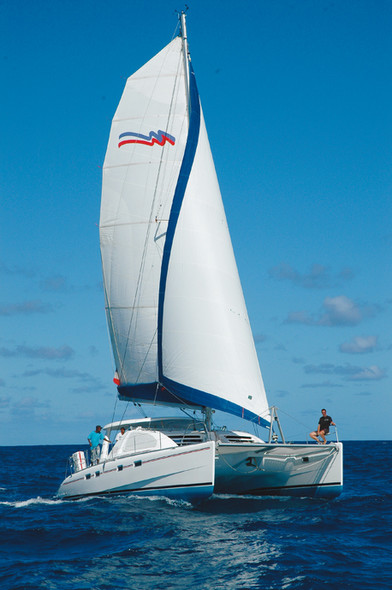
With varied conditions, up to 35 knots, we were really able to explore the Léopard 43’s potential…
An extended test
We took possession of our catamaran in the Oyster Pond marina, on the French part of Saint Martin, in the West Indies. It was number 18 in the series, registered at Nice in ...
To read in full, Buy the boat test
Tags :
- Boat review
What readers think
Post a comment
No comments to show.
Share this article
Follow us on, vous avez ajouté " " à vos favoris., vous avez supprimé " " de vos favoris., in order to add this article to your favorites, please sign in..
- BOAT OF THE YEAR
- Newsletters
- Sailboat Reviews
- Boating Safety
- Sailing Totem
- Charter Resources
- Destinations
- Galley Recipes
- Living Aboard
- Sails and Rigging
- Maintenance
- Best Marine Electronics & Technology

- By Mark Pillsbury
- Updated: December 9, 2011
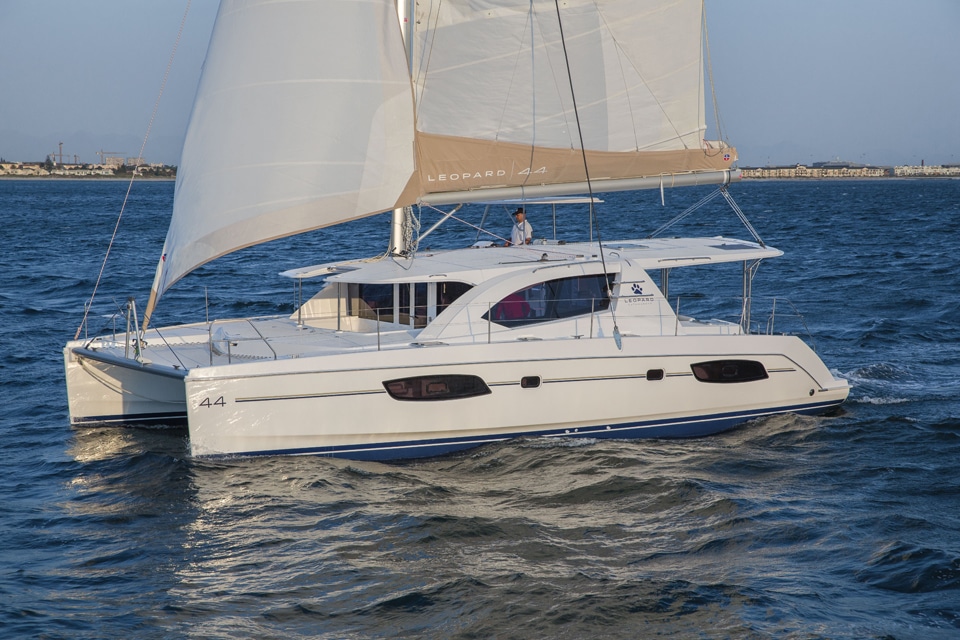
South African catamaran builder Robertson and Caine and veteran multihull designers Morrelli & Melvin teamed up once again to produce the new Leopard 44, which is also available for charter as the Sunsail 444. The builder’s longtime role as the supplier of catamarans to both Sunsail and The Moorings means that the build team has extensive owner and charterer feedback when it comes time to launch a new model. The result has been cats that are easy and fun to sail, ruggedly built to avoid downtime when in charter, and relatively affordable ( view the complete photo gallery here ).
In those respects, the new 44-footer should fit right into the fleet. The most distinguishing feature on this catamaran is the cabin top that extends forward, past the saloon, to shade a forward-facing cockpit located just aft of the trampoline on the bow. While we were motoring north from Miami to Fort Lauderdale one evening last winter after the boat show, this cockpit was the place to be as the sun set. The view was tremendous and the breeze refreshing as we skipped along with a crowd aboard at a little better than 6 knots at 2,600 rpm. Throttling up to 3,200 rpm, we added another half a knot. Two 29-horsepower Yanmar diesels are mounted facing backward, well aft in each hull, with saildrives forward of them; under way, this reduces noise levels in the aft cabins.
Earlier, with the boat under sail, I’d found it simple to maneuver, with all controls, including the halyards, leading back to winches at the raised helm to starboard. There, the skipper sits just about at bimini level under a hard dodger; an overhead port provides a view of the main. In 13 knots of breeze and open-water waves, we made 6.5 knots while sailing closehauled, tacking through about 110 degrees.
A Sunsail representative quipped that the boat was designed with the Caribbean and its steady easterly trades in mind. One can enjoy sunrise and breakfast around a small table in the forward cockpit, leave the watertight door open as a steady breeze blows through the saloon all day, and then enjoy sunset in the large shaded cockpit astern, with dinner around a table that should seat eight with ease.
Access from the dinghy or when swimming has been simplified via transom platforms that extend slightly past the side hulls, conveniently located handrails, and just a single step leading to the bridgedeck. Once you’re aboard, wide decks make for easy movement fore and aft, and the bimini’s overhangs provide sure handholds.
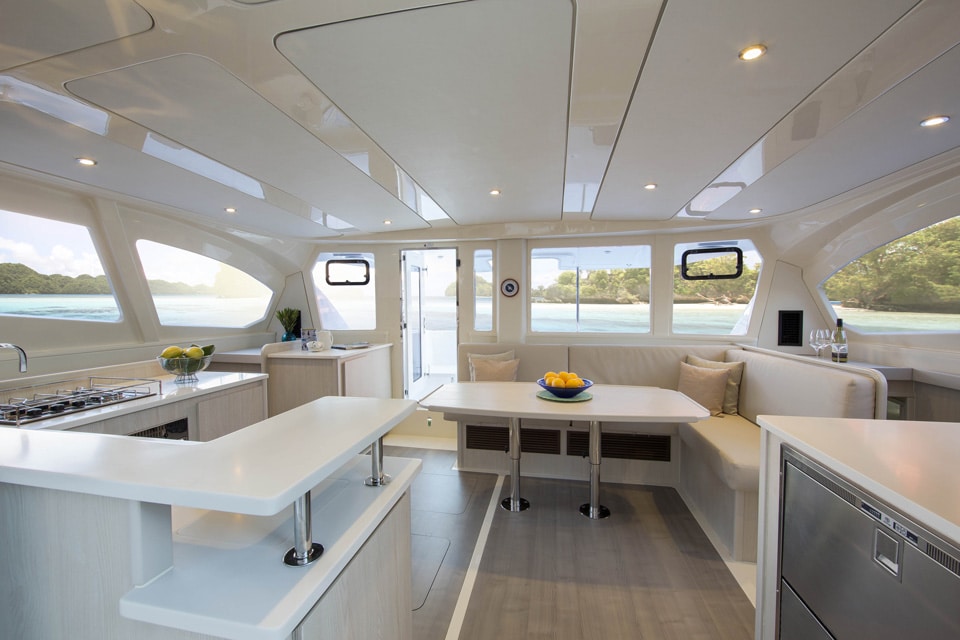
The boat I tested was a private owner’s version, with the accommodations for the captain and mate taking up the entire starboard hull. A queen berth is aft, with a sitting area amidships and a head with separate shower in the bow, behind a watertight bulkhead. To port, double berths with en suite heads are fore and aft, with a child’s berth far forward. That same layout is mirrored to starboard in the four-cabin Sunsail 444.
Hulls are constructed using isophthalic gelcoat and vinylester resin to resist osmosis. Balsa coring in the hulls and deck reduces weight and adds strength and stiffness. Hard chines and hulls that flare above the waterline provide both performance and increased interior volume. There’s plenty of the latter—and it’s well appointed, to boot. The doors fore and aft in the saloon, plus opening hatches, let in lots of light and ventilation. The interior decor is a blend of cherry laminates with white panels and light-colored upholstery. The up-style galley—with the storage and kit one would expect for a boat this size—is located aft to port and includes a two-drawer fridge and freezer and Corian counters. An optional generator is located forward, in a cockpit locker.
Overall, there was much to like about this latest offering from Robertson and Caine, and if I were a betting man, I’d wager that the concept of a cockpit forward might just set a trend for tropics-bound cats in the future.
- More: 2011+ , 41 - 50 ft , catamaran , Coastal Cruising , leopard catamarans , multihull , Sailboat Reviews , Sailboats
- More Sailboats
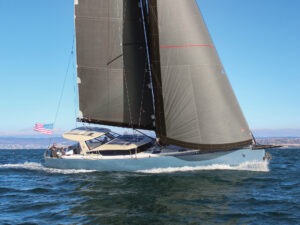
New to the Fleet: Pegasus Yachts 50

Balance 442 “Lasai” Set to Debut

Sailboat Review: Tartan 455

Meet the Bali 5.8
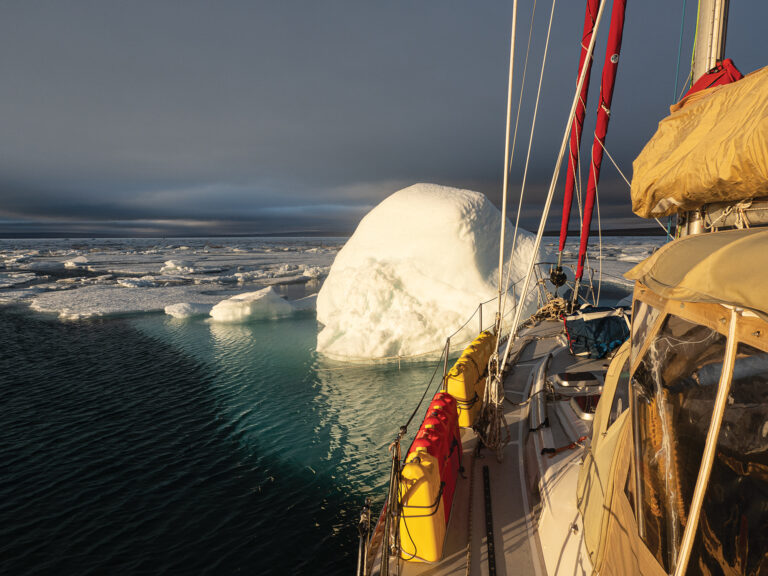
Cruising the Northwest Passage

A Legendary Sail

10 Best Sailing Movies of All Time
- Digital Edition
- Customer Service
- Privacy Policy
- Email Newsletters
- Cruising World
- Sailing World
- Salt Water Sportsman
- Sport Fishing
- Wakeboarding

Catamaran Review- Leopard Powercat 43
Leopard Catamarans is well known in the boating world for their quality designs and manufacturing. And their 43 Powercat is no exception. Outstanding details went into every aspect of conception for this incredible catamaran as seen in the hull, interior, and everywhere else on the boat.
Experienced builders Robertson and Caine are responsible for the bones of the vessel and the exterior design is the work of noted design company Simonis Voogd Design. Some might think of the Leopard 43 Powercat as the upgraded version of the 39 Powercat. But it is its complete replacement, ranking high in catamaran reviews.
This mid-sized catamaran is brilliantly designed with a stepped hull that allowed the manufacturers to increase the interior space above the waterline. This permits cruisers to have a more open layout in the hulls without decreasing the yacht’s performance. There are noticeable upgrades with the slender hulls and a reduction in wetted space below the waterline.
Naval architect Phillipe Subzero drew the hull lines for the Leopard 43 Powercat . Subzero is a famous catamaran designer who specializes in passenger style formation.
The hulls he drew were designed to maintain a level position and augment clear sea passages. His ideas were perfect for a yacht that speeds along between twelve and twenty-four knots, depending on the owner’s choice of engines.
The Leopard 43 Powercat can reach twenty-four (24) knots without compromising on fuel efficiency. This yacht has a sizeable flybridge that includes a wet bar, BBQ grill, and access to the sunbathing area that can seem straight ahead.
The interior galley is located forward. And the settee and table are located aft. This ingenious design lets cruisers have a panoramic view of the outside.
Those on board can relax in the aft cockpit seating area and see out the sliding glass doors in front of the settee. A huge window and access door to the bow can make the inside feel more like outside without subjecting cruisers to the elements.
Inspiration and Comparison to Other Models

The makers of the Leopard 51 Powercat decided that after its completion there needed to be improvements made in the efficiency of the hull. They invested in a testing program inspired by the Powercat 51.
At the conclusion of their experiments, Leopard was able to develop a yacht that can achieve speeds comparable to the Powercat 51, even though it uses two hundred twenty less horsepower and is eight feet shorter.
The usable space onboard may remind catamaran enthusiasts of the Leopard Powercat 40. The flybridge area is close to what buyers will get from the Powercat 51, and the interior volume is thirty percent larger than what they would get from the Powercat 39.
Leopard 43 Powercat Specifications

The beam of the Leopard 43 Powercat measures twenty-two feet and one inch. The LWL is forty feet and ten inches. The draft is three-foot and one inch and the LOA is forty-two feet and eight inches. The Leopard PC 43 uses 2 two hundred twenty horsepower motors to power itself through the water. The fuel tank can hold two hundred sixty-four gallons.
Some features can be designed according to the owner’s wishes. There can either be six or eight berths and three or four cabins depending on the boater’s preference. There are two heads and two showers.
The maximum load capacity onboard the Leopard 43 Powercat is eleven thousand twenty-three pounds. And its displacement weight is twenty-five thousand seven hundred ninety-four pounds. The waste tank can hold up to twenty-four gallons. The catamaran’s water tank can hold two hundred six gallons.
Catamaran Reviews

Favorite blogs and forums that feature catamaran reviews from real-life yacht enthusiasts reveal an overall satisfaction from purchasers of the Leopard Powercat 43. There was almost nothing negative to report from those who have gone cruising onboard the vessel.
One thing that did deter some catamaran shoppers from buying the Leopard 43 Powercat is the balsa coring. Some luxury boaters will not purchase a ship if it is filled with any balsa below the water level. Balsa has a bad reputation among some cruisers for being prone to damage and hard to maintain.
Owners of the Leopard 43 Powercat feel that the balsa is no issue because it is high quality. No catamaran reviews so far indicate an owner was having trouble maintaining the balsa. What owners are most satisfied with is the speed they get out of the 43 PC. Most catamarans of similar size using similar engines use much more fuel and are significantly slower.
Leave a Reply Cancel reply
Your email address will not be published. Required fields are marked *
This site uses Akismet to reduce spam. Learn how your comment data is processed .

- Subscribe Now
- Digital Editions

VIDEO: Leopard 43PC review
A wholesale update of the 39PC, the new Leopard 43PC proves itself as one of the best small power catamarans on the water
The Leopard 43PC is an updated version of the 39PC, though it is an update far more comprehensive than a quick facelift and some new engines.
No, from the hulls upwards the 43PC is different to its predecessor and had been desinged from the off to be a power cat.
This translates to the performance where, thanks to a pair of 260hp Yanmar diesels, the 43PC will top out at over 20 knots. Conversely, throttle back to 6 knots and the range rockets to nearly 1,500 miles.
Some of the biggest changes come on deck where the orientation has totally changed and Leopard have added a door at the front of the saloon to the vast foredeck.
The flybridge is also much improved over the 39, with a far better layout and access from the cockpit and a gate forward.
Below deck you can either have four double cabins sharing two bathrooms (prime charter spec) or a full-length master in one hull with two guests cabins in the other.
Power catamarans certainly aren’t for everybody but if you’re in the market then the 43PC is a cracker.
Read the full report in the September 2016 issue of MBY .
The Busy Boater
Exploring boating from a renter's perspective


Yacht Rental Review: Leopard 43 Powercat
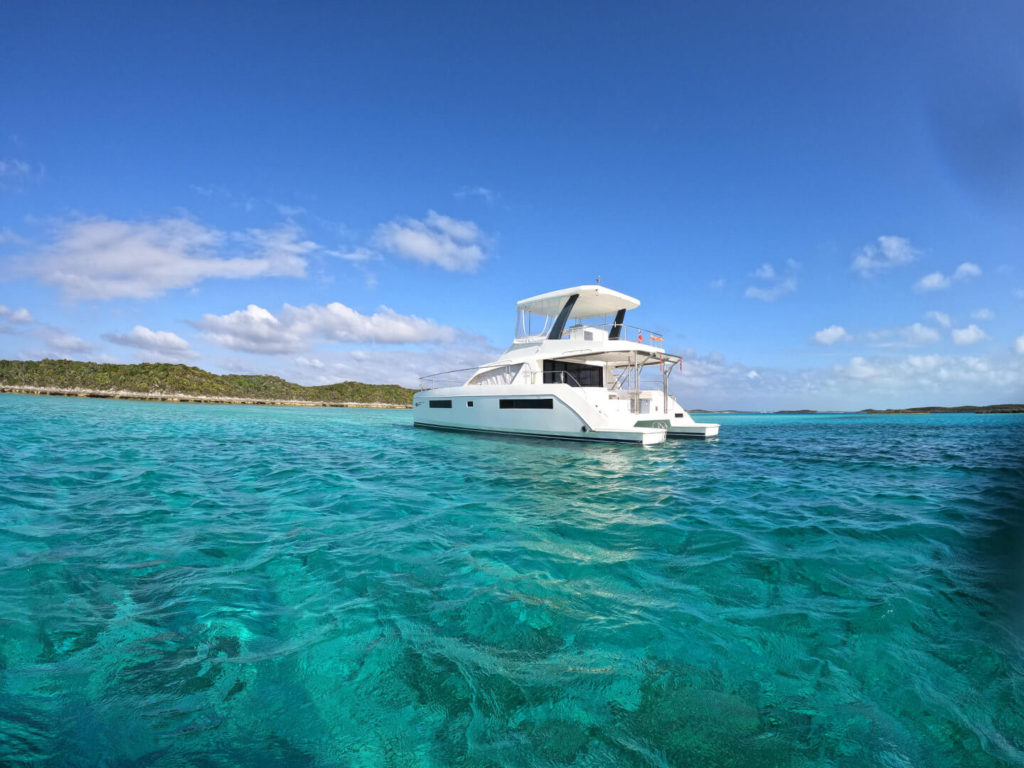
What advantages does a power catamaran have over a sailing catamaran? To find out, we bareboat chartered the Leopard 43 Powercat (aka 43 PC) from The Moorings in Nassau, Bahamas to cruise the Exuma Cays for a week. Let’s see how fast she goes, much fuel she burns, how much gear she can store, and how she handles in the marina and at sea.
- Twin engines make close quarters maneuvering a breeze
- Tons of storage and space to swing your arms
- Speed to support an aggressive itinerary
- Shallow draft for navigating shallow water
- Disappointing handling in heavy seas
- Thirsty on fuel when compared to sailboats
- Poorly looked after by The Moorings/Sunsail Base in Nassau
How Big is the Leopard 43 Powercat?
The Leopard 43 Powercat is the smallest power catamaran in the Leopard line. She blends the bones of the Leopard 40 sailing catamaran and the Leopard 51 Powercat. Between the waterline and the salon roof, the 43 PC seems almost identical to the Leopard 40 sailing catamaran, carrying her extra three feet in the swim platform…possibly to improve prop pitch and trim the yacht out while on a plane. However, like the Leopard 51, she has over 500 horsepower to get up on a plane and GO!
She also shares similar lines to a Leopard 51 with a hard-topped flybridge in lieu of a boom, mast, and cockpit helm. This easily doubles the outdoor deck space compared to the Leopard 40. She also trades a trampoline up front for a hard-decked bow. With a draft of 3’1″, the 43 PC is a full foot shallower than the 40-foot and 2″ shallower than the 51. This is also an improvement of three feet or more when compared to sailing monohulls in this size range. Heck that’s even a few inches less than the Nordic Tug 26 we tested last year. In the shallow waters of the Bahamas, this gave us a ton of confidence when venturing close to shore and through shallow passages.
How does the Leopard 43 Powercat compare to other types of yachts? Being a catamaran, the 43 PC is incredibly roomy compared to monohulls. I’m not aware of a monohulled powerboat under 50 feet with four very usable staterooms and two heads. While you might find those sleeping accommodations in some monhull sailboats under 50 feet, you won’t find them with the deck space and storage space that you’ll get on the 43 PC.
Even among catamarans, the 43 PC gives you a lot of yacht in 43 feet. Compared to the 38-foot Lagoon sailing catamaran we chartered in the British Virgin Islands , this yacht felt much larger in every part of the yacht. Leopards are designed for the charter market and prioritize space and comfort at anchor. On internet forums, yachts designed for bareboat charter like this one are derisively referred to as ‘condo cats’. I think it is an accurate metaphor, but I don’t take exception to it. Boats are a series of trade-offs, and this one ticks a lot of boxes for the Busy Boater crew that’s just looking for a week of low stress near shore cruising. We aren’t looking to make ocean crossings or deal with long-term ownership issues.
So, while the Leopard 43 Powercat is a small 43 footer by Leopard’s standards, it is about as much boat as you’ll find packed into 43 feet elsewhere.

At the Helm of the Leopard 43 Powercat

This power cat has one helm station. It is located on a flybridge that caps the salon and cockpit. Most of the flybridge is covered by a hardtop. It comes standard with vinyl windows on three sides to protect you from the weather. Without a lower helm, this feature is very handy. When you are cruising at 15 knots against a 20 knot headwind, that’s 35 knots of wind at your face. Add in some rain, and it ain’t a pleasant experience without at least this plastic sheet to shield you from the weather.
Luckily for us (/sarcasm), the yacht we chartered did not have its front vinyl panels. We asked to swap or pull some from another yacht, but were denied. This made running in a downpour on our first day out a downright miserable experience. We were surprised to also get sprayed all the way up here when cutting through some 4-foot seas in Exuma Sound. The windows can be rolled up out of the way on a nice day, or, like in our case, when an incomplete set gets ripped from its threads and you have to makeshift repair them at sea.
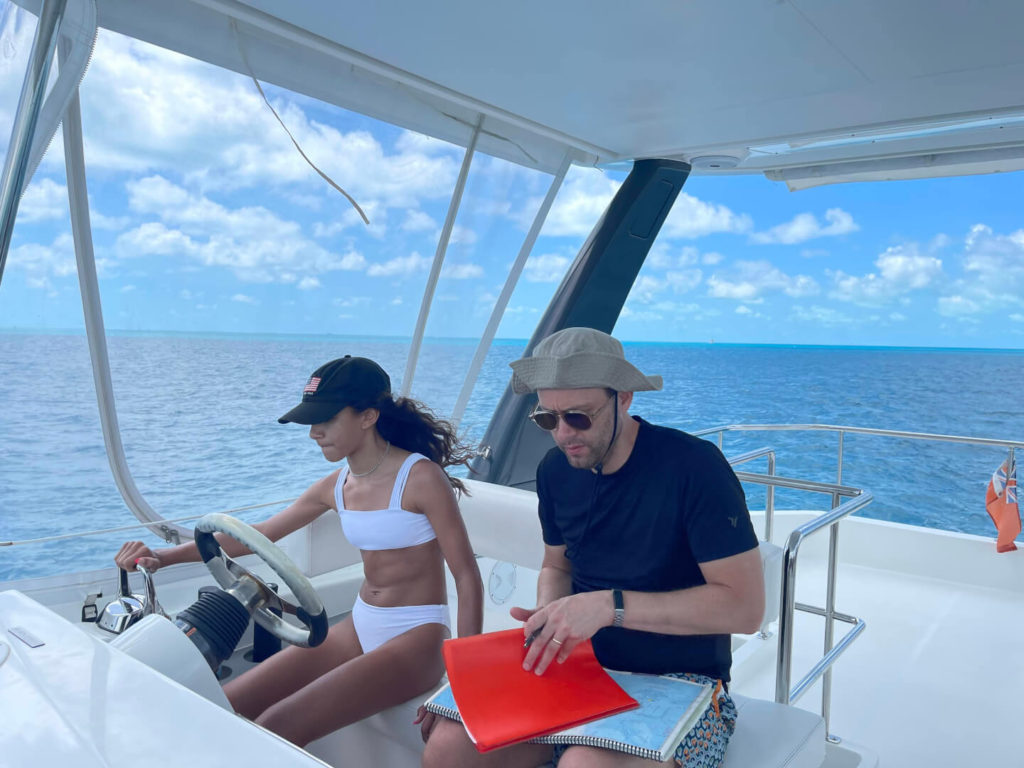
The helm seat is against the port (right) side of the flybridge. The seat is wide enough for two to sit comfortably with space in between. However, the small wheel is offset to the right and the throttles are set low and to the right of the bench. So, its hard to share the controls or take over when training a newbie. While the seat is very comfortable, the controls are mounted too low to stand at the helm, and there isn’t much to hold on to or lean on. Although, when getting drenched in a deluge one day, I set the autopilot and watched from the back of the flybridge at the stairway to get a bit further out of the rain.
The Yanmar engines come with electronic controls. The throttles can be synced to run at the same speed with a single handle when cruising. On twin engined powerboats you can sometimes find the engines out of phase just enough that they resonate with an annoying wah wah sound and vibration, but electronically synchronizing throttles eliminates that. The Yanmar engine display only showed the status of one engine at a time, and we were unable to figure out how to toggle between the two. You could watch RPMs on the Raymar multi function display, but I had to crane my neck to the left to see them while adjusting the throttles on the right.

Electronics

The Leopard 43 Powercat comes from the factory with a VHF mounted above the electrical panel in the salon with a remote VHF mic hung on the side of the helm. At the Moorings Nassau base, they remove these because they get damaged by the salt spray…like my hat, face, etc. No matter, our VHF didn’t work anyway. The yacht had a charging station for a handheld VHF, but that too was missing.
Our yacht had onboard wifi available from The Moorings for a fee. We spoke with returning charterers at the base who said it was no more effective than the wifi on their cell phones, so if you have a good international cellular plan or a Bahamian SIM card, this isn’t a worthwhile option. We did find that when cell signals were weak, we could turn set one phone up as a hotspot and leave it on the flybridge for better reception and connect to it with other phones in the cabins to improve performance.
The yacht has a Fusion stereo, controlled with the RA70 head unit at the electrical panel and MS-NRX300 remotes at the helm and the galley. This system is a very popular OEM choice for good reason. It is solid, simple, easy to use, and easy to read in harsh conditions. Plan to bring a few mixes downloaded to your phone to pair to the Bluetooth as access to radio stations and cellular internet may be spotty. There’s also no holes for CDs or tapes.
You can control everything from the remote units except balance levels across the four zones: bow, salon, cockpit, and flybridge. The zones could only be controlled from the head unit on the electrical panel. This wouldn’t be annoying except that if you have one zone turned all the way down at the head unit (to mute it), but turn the volume up from a remote, it brings each zone up proportionally and will turn on the muted zones. You can overcome this by controlling the volume on your phone. With a pair of 6.5″ marine speakers in each zone, you can crank it up plenty enough to annoy everyone in the anchorage, but you won’t be blowing any doors off. We had to tinker with the tone and volume settings to get a reasonable volume on the flybridge that overcame the engine and water noises without distorting while underway.
Raymar Electronics Suite
A suite of Raymarine electronics is included from the factory with two multifunction displays that can show tank status, engine status, chartplotter, fishfinder, and a camera pointed at the stern. It does not come equipped with a radar or AIS. The two displays are different sizes, but work identically and can toggle between the same screens. We used the larger screen for the chartplotter and the smaller to show the engine and fuel info while under way. The displays could also had a screen for levels of tanks and batteries, as well as an alarms screen that demanded attention with loud beeping until you toggle through and acknowledge.
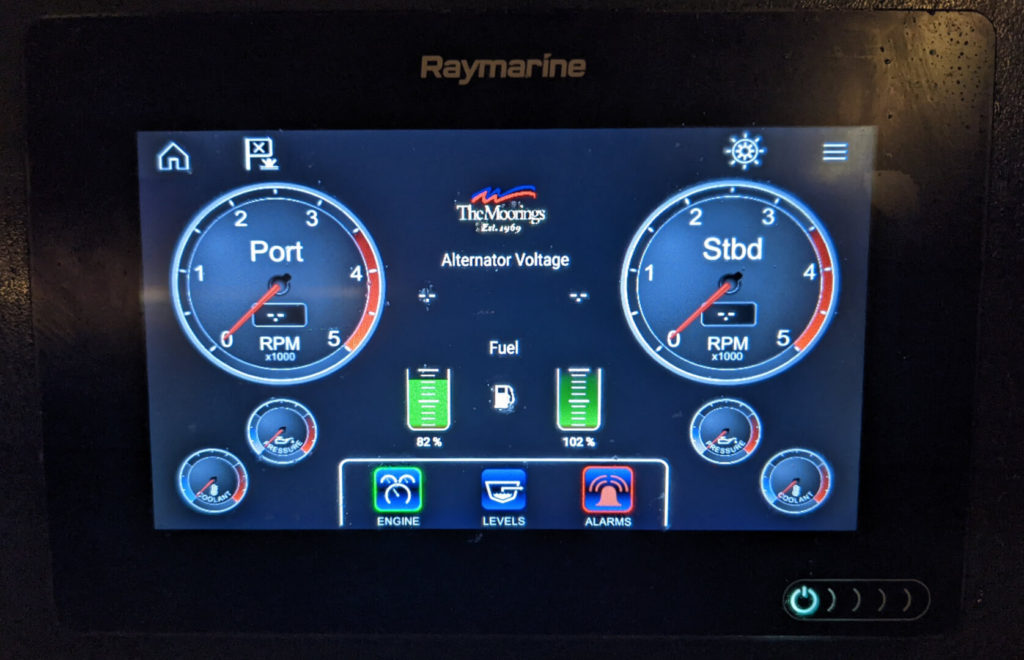
The multifunction displays are touch screen and work very effectively with two exceptions. One, the power button is a PITA, so we mostly left them on and covered in the evenings. Two, once sprayed with saltwater, the touch functionality is seriously impaired; this is not good when in rough seas trying to adjust the chart.
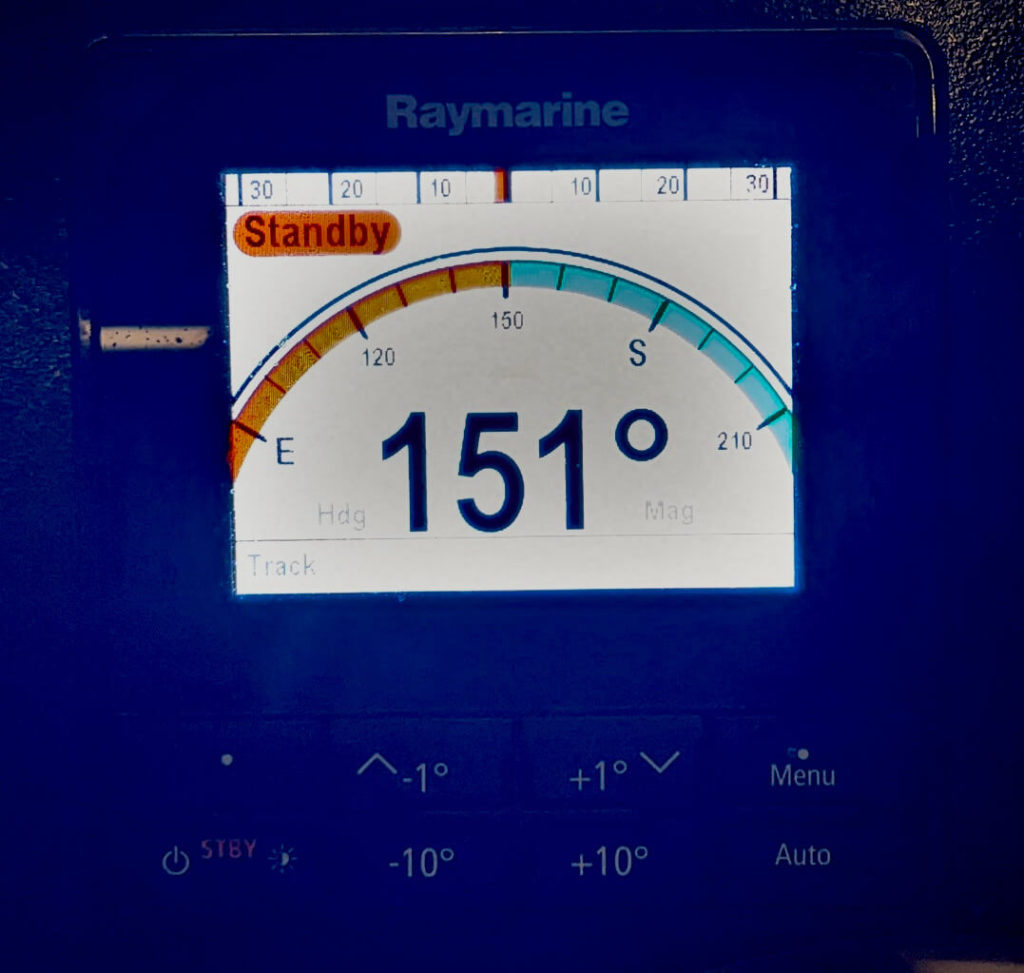
There’s also a separate screen to control the autopilot that includes rudder indicator (you know how I love rudder indicators!) and heading. There is no water speed indicator on this yacht, only speed over ground from the chartplotter.
According to Raymarine, the chartplotter module can be connected to the Navionics boating app on your phone to transfer waypoints and routes. We were unable to connect Navionics to send our waypoints. The checkout skipper didn’t know that was possible, but was eager to figure it out. The manual was not helpful (common theme), but we eventually found the menu and needed a password to connect to wifi, which we didn’t have.
Under Way in the Leopard 43 Powercat
The Leopard 43 Powercat has relatively small rudders, so the yacht is not very responsive to the wheel at slow speeds, and do not induce a pivoting turn like you’d expect on a yacht designed for slower speeds. What I mean to say is turning the yachtt with the wheel SUCKS. However, with twin engines placed a mile apart, it was a breeze to maneuver using the throttles. One engine in forward gear and one reverse easily spins the yacht within its own length. Running one engine at a higher speed than the other, or bumping one into neutral, are very effective at turning while running. Once over 5 knots or so, I relied almost exclusively on the autopilot, which again was easier than maneuvering the teeny little sport wheel. So I never really used the wheel, but the kids always insisted on using it when they took the helm.
There are no trim tabs to adjust the height of the bow while on a plane for comfort and efficiency. I don’t understand the physics, but this is apparently common in catamarans. The yacht did maintain a good trim at different speeds and sea states, regardless.
We found ourselves almost exclusively on the flybridge when underway. When running on a plane, the yacht has enough bounce that its a bit unnerving to climb down the stairs and be anywhere near the stern. Unlike most motoryachts, the stern is open on the sides, and our yacht was missing a lifeline down the center. You also get more engine noise in the salon, and when in rough seas, you get some nasty hull slap that isn’t really noticeable on the flybridge, but throws the floor and table with quite a crash down below.
How Does the Leopard 43 Powercat Handle Rough Seas?
When I describe rough seas, everything is relative. For most of our weeklong charter on this yacht we were on the Exuma Bank, protected from rough seas by the Exuma Cays. When crossing the yellow bank from Nassau, where the sea is a bit more exposed, we got some 1-2 foot seas, which the yacht smoothed right out when on a plane.
One day we crossed a cut between the island chain out into the Exuma Sound to save some time. Well, honestly, we also did it to say we’d crossed a cut and spent time in the Sound…and to give you the yacht test you deserve. The cuts, which are thin channels between the islands, can be challenging because the tides create a lot of current as water is exchanged from one side of the islands to the other. When the current is against the wind coming in from the Sound on the east side of the islands, the surface water in the cuts can also be very violent. However, with 640 horsepower at the stern and good timing, the cuts themselves were no match for us.
Surprisingly though, once out in the Sound, we found some very confused seas. The waves were only four feet, but very close together, maybe a second or less apart. They were mostly (but not all) coming from the East, so we’d have them at our bow on the way out, beam on the way north, and stern as we crossed back into the Exuma Bank.
Taking the waves head on, I was deftly afraid of stuffing the bow and learning more than I ever wanted to about nets vs solid catamaran bows. Then, when we had the waves at our side on the beam, the yacht rocked too and fro with such velocity that my stomach would get roller coaster like butterflies…sitting up high and exposed in the flybridge, this was downright scary.
We found the smoothest ride ‘quartering’ the seas with the waves 45 degrees off the bow with the hammer down going over the waves as quickly as possible. However, we still got pounded something fierce. The bow of the pontoon on the side taking the wave would occasionally plow under it and throw buckets of water up to and across the flybridge, drenching the entire crew.
Perhaps more unsettling was that there’s not much in the way of good handholds when sitting on the U-shaped settee (couch), or on the inboard side of the helm seat. Meanwhile, down below in the salon, the kids thought this roller coaster ride was a blast, jumping with the hull slaps…until one blew ramen chunks in the sink…then the microwave broke loose and fell in the dish drainer, and they realized things were a bit serious and took their seats…using a foot to keep the broken refrigerator drawer from swinging in and out.

Finally, with a rising tide, we had wind waves and current at our stern when we headed back through a cut North of Warderick Wells. Well prepared to ride the surf like a boss after doing it in Maui , we cautiously turned toward the cut. Unlike the nimble 24-foot catamaran we had there, this yacht could not go as fast as the surf to maintain control. Even with the hammer down, the waves would crash at our bow, pushing us well over 20 knots! I was able to maintain control by throwing the engines in reverse to get behind the waves as they caught us. We didn’t need to turn until we got out of the surf, but if we had, I’m certain we could have turned out with the throttles, but I’d be wary of counting on our tiny rudders to be much help.
Our yacht was equipped with twin Yanmar diesel V8s with 320 horsepower. These are optional engines. The base engines are 260 horsepower straight sixes; also Yanmar Diesel. Access to fluids was relatively easy, with the dipstick, oil filter, coolant, impeller, sea strainer, and fuel filter all located towards the front of the engine. The sea strainer was located above the water line, allowing it to be cleaned without closing the through hull: if you open a sea strainer below the water line with an open through hull, sea water will rush into the yacht making a mess and causing panic…if you close the through hull to work on the strainer, but then forget to open it when done, you’ll overheat the engine. So this is a simple improvement to help overcome some of our stupidity.
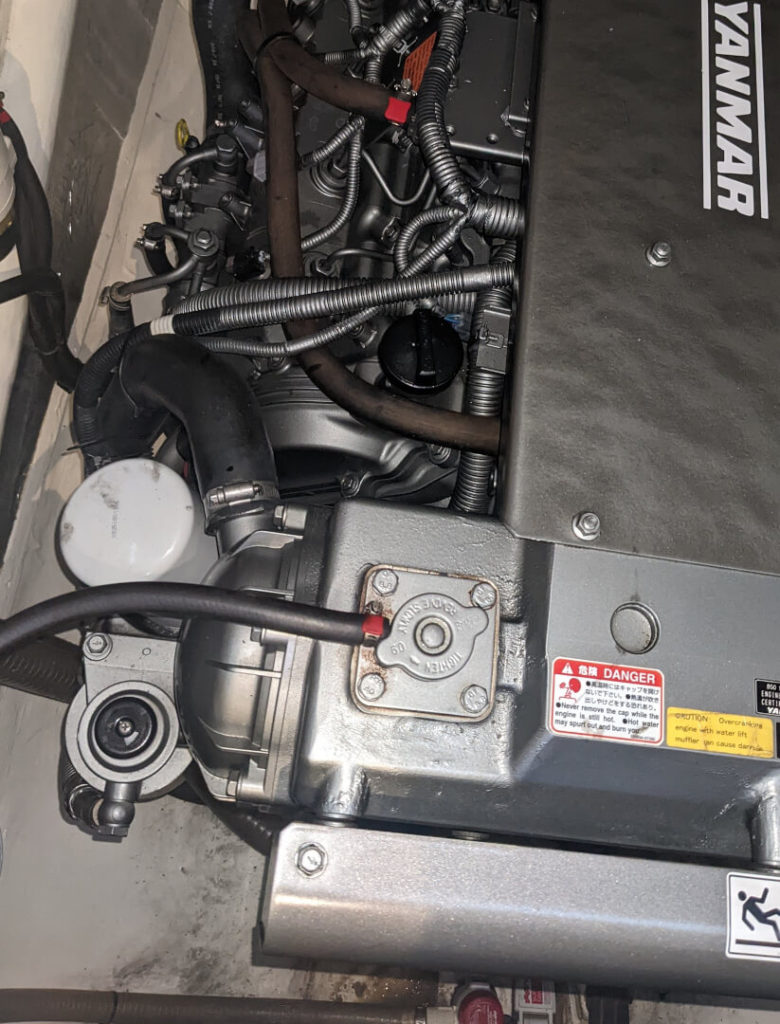
How Fast and Fuel Efficient is the Leopard 43 Powercat?
Without a water speed indicator, or a GPH indicator (that we could find on the MFD), we were unable to precisely measure the engines’ performance. In charter service the engine’s throttles are limited by a piece of plastic screwed into the side of the throttle controls. With the limiter in place, we were able to get the engines up to 3,000 RPMs and cruise around 17 knots (20 mph) in calm seas. This was about a knot slower than specs we read on the internet, which might be credited to the very dirty hull we got. Expect to lose about 2 knots off the top end with the standard 260 horsepower straight-six engines.
What is the Benefit of the Powerboat Speed?
While most of our hours were running with the hammer down at 3,000 RPMs, we also found a comfortable cruise at 2,000 RPMs where we made 9-10 knots and 1,500 RPMs where we made about 7 knots. A 17-knot cruise is 10 knots or 140% faster than we’d expect to motor on a similar length sailboat.
This speed allowed us to run 78 nautical miles from Nassau to the Southern end of our cruising grounds at Big Major Cay in just over 4.5 hours. With our 1:00pm departure, we would not have been able to make that run by sundown on our first day. On our last day we were able to slow down a bit and still run the 37 nautical miles from Highbourne Cay back to Nassau in 2.5 hours. With the yacht due back to Moorings/Sunsail in Nassau by 10am, this would again not be possible in a sailboat.
So, when chartering in a big cruising ground like the Exumas, the powerboat speed buys you, at a minimum, one extra night in the out islands as you really need to head back to the marina the night before a 10am turn-in with the sailboat.
How Much Fuel Does the Leopard 43 Consume at Speed?
On our weeklong trip we burned 185 gallons of fuel with 13 hours on the generator and 18 hours on the engines. Northern Lights states that the 9kw genset burns 0.5-1 gallon per hour (so we’ll assume 13 gallons for the generator). We ran the engines for 11 hours at 3,000 RPMs, 1 hour at 2,000 RPMs, and 4 hours at 1,500 RPMs. We ran mostly at 3,000 RPMs before our first refueling, so I can estimate that we burned about 16 gallons per hour with the hammer down at the 17-knot cruise. That’s actually about 2 gallons per hour better than the internet told us to expect.
With 264 gallons of tankage, we could have gone the full week without refueling, but we did refuel after our big run south on the first day (90 gallons). At sea, it isn’t wise to plan to burn more than half of your fuel, especially when you aren’t familiar with the boat. On a similarly sized monohull, we might would have run 34 hours to make the same distance, but closer to 1 gallon per hour. So, fuel burn would have been less than 50 gallons under comparable use on the monohull, or much less if we sailed and used less generator. However, running a speed in the mid-teens at about one gallon per mile like we did is very comparable to a similarly sized pilothouse monohull motoryacht.
The engines are mounted under the beds in each of the stern staterooms. Many sailing catamarans have the engines mounted further aft (towards the stern). Often in these cases, a sail drive is used to allow the prop to mount at a perfect 90 degrees to the hull. However, sail drives are not rated for the kind of horsepower this cat carries. So, like most motoryachts, the Moorings 43 power cat uses a driveshaft that puts the prop at an angle. The more angle on the prop, the less efficient it will work. So mounting the engines as far forward as possible reduces this angle. With regular access needed below the bed, the platform is raised and lowered on a motorized switch.
I was surprised at how quiet the engines were under way. While, they were nowhere near as quiet as our Nordic Tug 26 , they were tolerable even when in the laying in the bed. directly above the engine. Sitting on the flybridge, you are far enough away from the engines that the noise isn’t bothersome at all.
Leopard 43 Powercat Galley
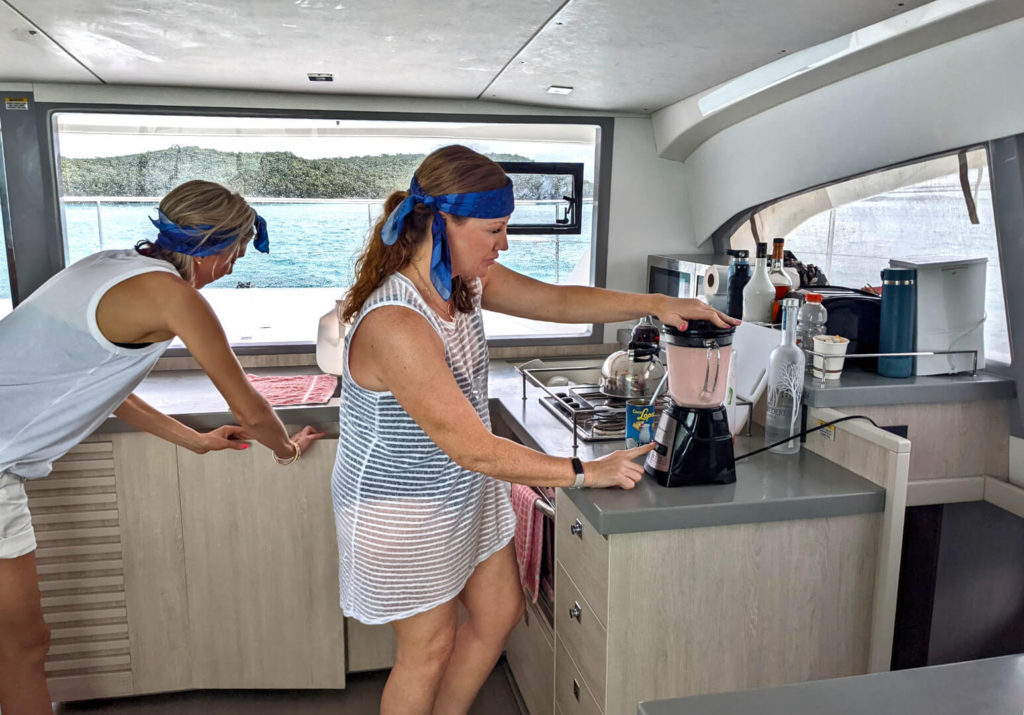
The galley in the Leopard 43 Powercat spans the port and forward edges of the salon. There’s a lot of counterspace with the dish drain recessed with a cover when not in use. The design also takes advantage of space that had to be elevated for headroom down below by elevating the rear of the counter for appliances and storage.
Galley Storage
There’s lots of storage with generous bins for in the salon floor. These work great for bagged dry items like cereal and rice if you remove the box before departing (also reducing trash to hold later)…just be sure not to step in them while open or not properly set or you’ll have little bits of ramen to clean without a vacum or broom/dustpan. There’s also a small cabinet in the stairwell for dry food storage. A very deep cabinet next to the sink holds a generous amount of cups, bowls, plates and storage bins for leftovers. A set of drawers next to the oven holds the utensils.
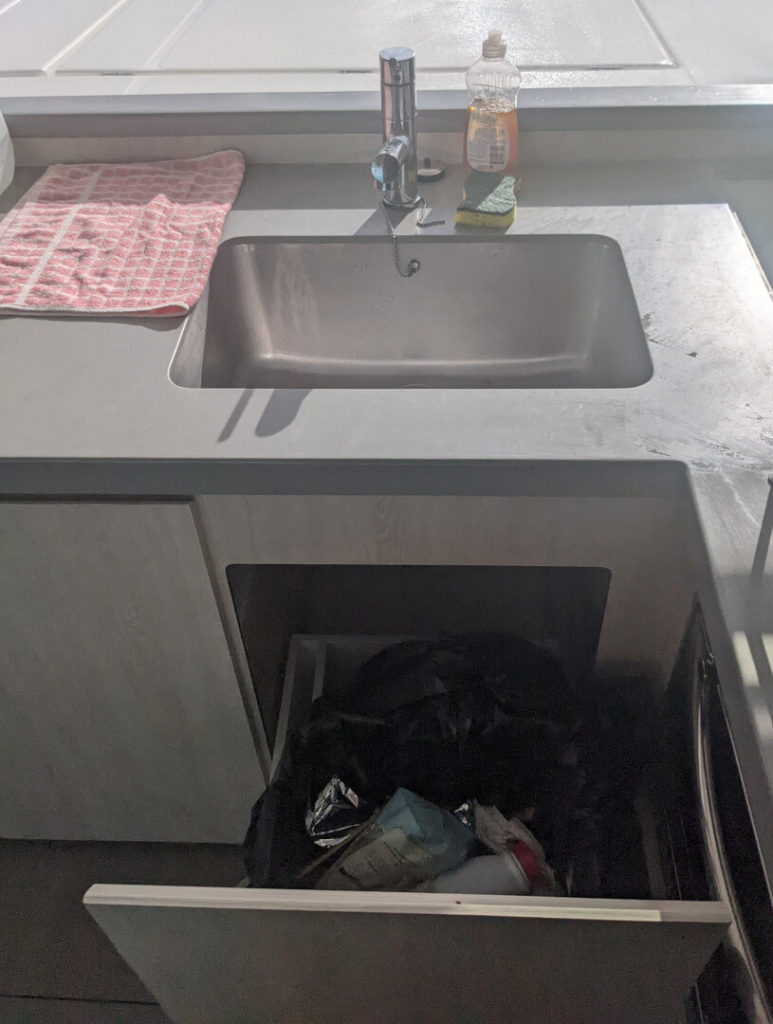
There was a trash drawer below the sink that hung two bins to allow for sorting.
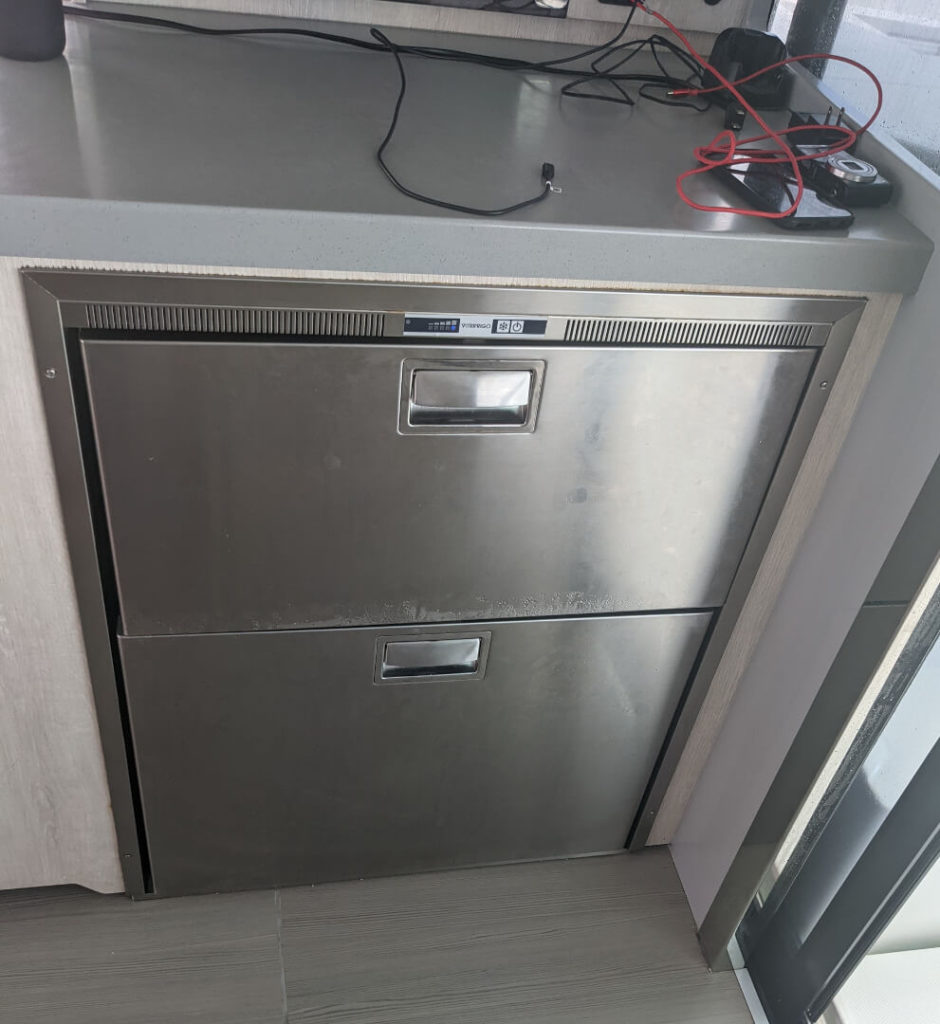
The combination refrigerator/freezer is away from the kitchen at the companionway door below the electrical panel. It utilizes two drawers to facilitate easy access down low. Our drawers were helplessy misaligned in their tracks, so the refer wouldn’t latch and would slide open and closed in rough seas, while the freezer had to be lifted and pulled open from beneath because it was too tight to get enough purchase with the handle.
The freezer was very effective at keeping things frozen. There was room for two 10 pound bags of ice in here plus more. It is cold enough to make larger blocks of ice to keep a cooler cold during your trip if needed. The bottom drawer is a fridge, while the top is a freezer. The fridge drawer was slightly larger with a shallower shelf in the rear 2/3 to make room for the compressor beneath. There is only one temperature control for both drawers. We had no trouble holding ice in the freezer all week without freezing anything in the fridge.
Galley Appliances

The 3-burner range operates on propane. The electronic ignition on the burners did not work, but The Moorings includes a grill lighter with utensils knowing they can be finicky. The stove was adequate, if a bit crowded, for preparing meals. The oven was relatively small, but included one glass and one aluminum pan that were designed to span the full width of the oven, allowing you to make the best of it…which was fine for anything other than a turkey or crown roast. Our checkout skipper was surprised that the electronic ignition worked on the oven, so plan on lighting that with the lighter too. We were unable to get the broiler to work, and the user manual only had info on installation, not operation. This wouldn’t have been frustrating if our flybridge BBQ was operational.
The range was equipped with an electric propane valve and propane sniffer. Our valve sounded the propane alarm during our sea trial. After finnicking with it for a bit and throwing the breaker, it stopped complaining, but the valve never closed, allowing propane to the stove regardless of setting. Our checkout skipper told us it was fine. While it wasn’t ideal, we closed the tank valves when not using the range and didn’t get blowed up.
Electric Appliances
Our test yacht was equipped with a microwave, blender, four slice toaster and coffee maker that all ran on 120v electricity. With no stovetop percolator or French press, that meant that you needed to start the generator to make morning coffee: put the first couple to rise in the starboard stern stateroom to minimize the impact. You could also consider bringing a pour over funnel or aeropress to reduce generator usage.
Another issue with the appliances is there are two 120v appliance circuits with one serving each side of the yacht. This meant that while there were three sets of outlets in the galley, they were all on the same circuit and could only power one appliance at once (without tripping breakers). So, we had to run the coffee pot from the chart table (which was on a separate circuit) in order to make toast and coffee at the same time. Finally, I will note that we started out with a fully functioning four slice toaster that failed on one side a few days into our trip and then eventually the other side failed, leaving us with floppy bread for the rest of the voyage.
The sink is served exclusively by the electric fresh-water pump. There’s no foot pump for sea water pre-rinsing, or as a freshwater backup to the electric pump.
Auxillary galley: flybridge grill station

All Leopard 43 Powercats come with an electric grill and sink behind the flybridge settee. Some, like ours, also have an additional refrigerator up here. The extra cold storage is theoretically handy for a long voyage with a large group, or just to keep beverage traffic out of the main fridge. Unfortunately, our refer control was broken and would not get below about 60 degrees, so we just used it for beverage storage. I also can’t tell you how the grill worked because ours had an electrical short that popped the GFCI breaker immediately when turning on. This would have been a great place to cook most meals while without heating or stinking up the galley/salon.

Leopard 43 Powercat Flybridge
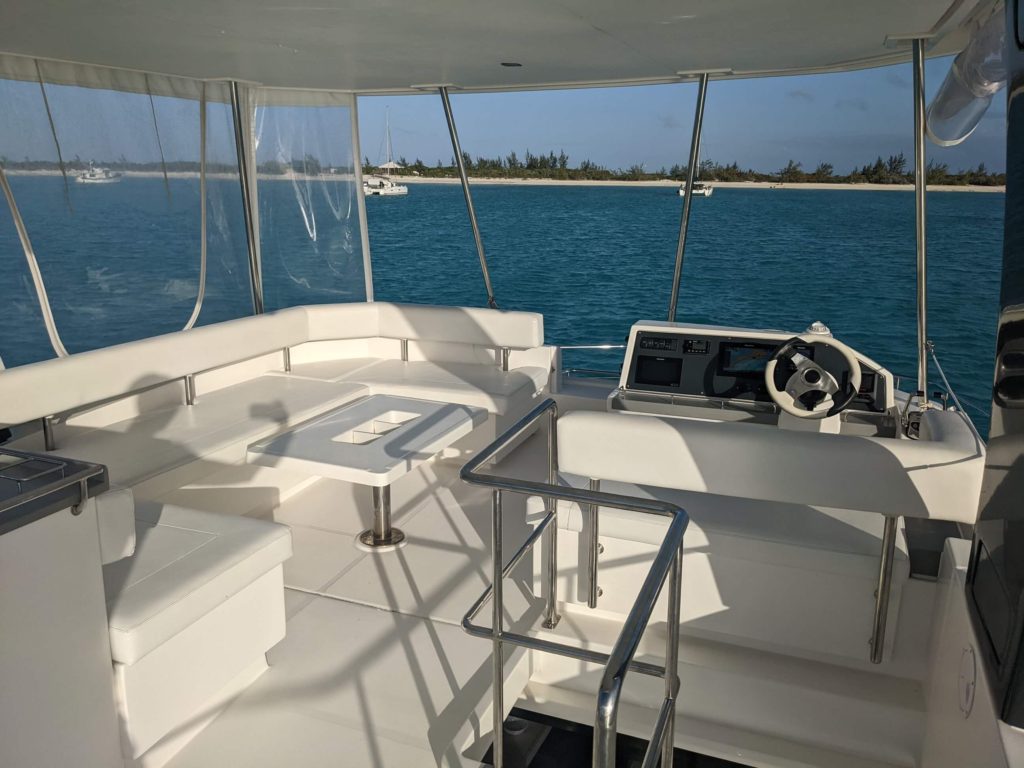
A big advantage of a powerboat over a sailboat, at least in this size class, is that the lack of a mast and boom allows for a large flybridge above the cockpit and the salon. When under way, the crew can sit with the wheelperson and enjoy an unobstructed 360-degree view. Our crew parked here almost exclusively while motoring. There’s lots of room up here to move around, sit, and lay down. A large table inside the u-shaped settee (couch) has three molded bins that are great for keeping phones, snacks, and water bottles from flying around while at sea.
A few downsides to note on this flybridge. There are only two cupholders up here, and they are located outboard of the helm seat, inaccessible to passengers. They also have an opening in the bottom that allows cell phones to slide out and fall on the floor. Perhaps more annoying: there isn’t much to hold onto when sitting at the settee. This can be very unnerving when getting tossed around in rough seas.
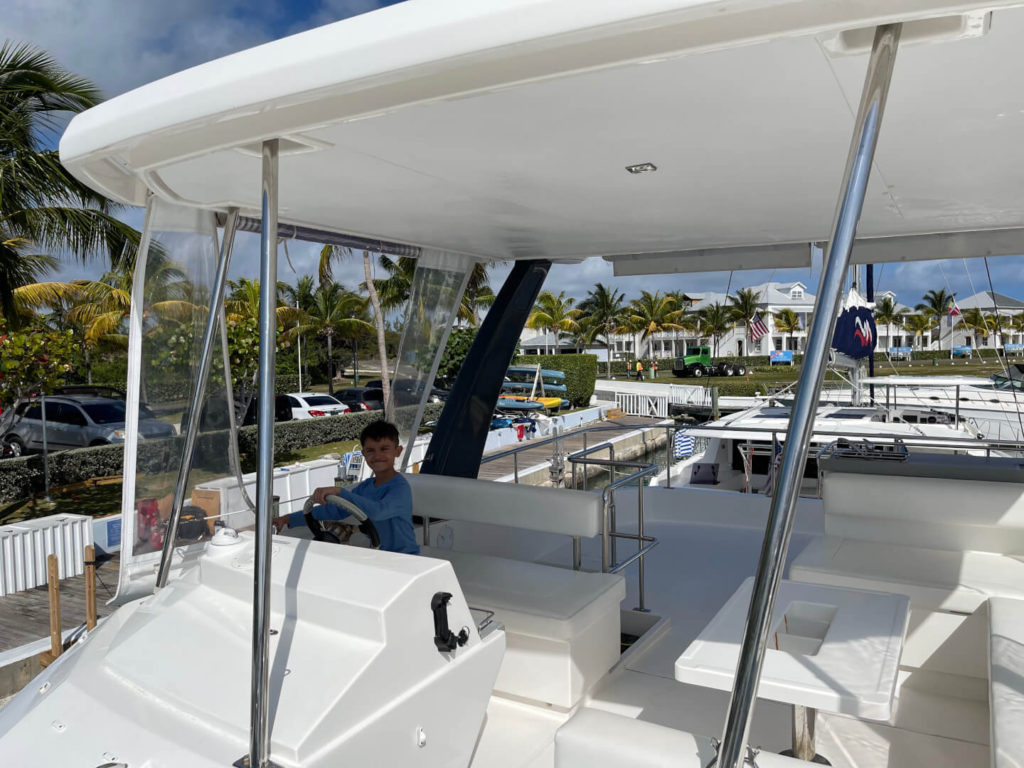
Ahead of the helm and settee, there is a passthrough to a sundeck that can be used while at anchor or under way in calm seas. In the absence of a trampoline on this cat, this ended up being our crew’s favorite spot to relax in the sun. There’s a back cushion, but no bottom cushion.
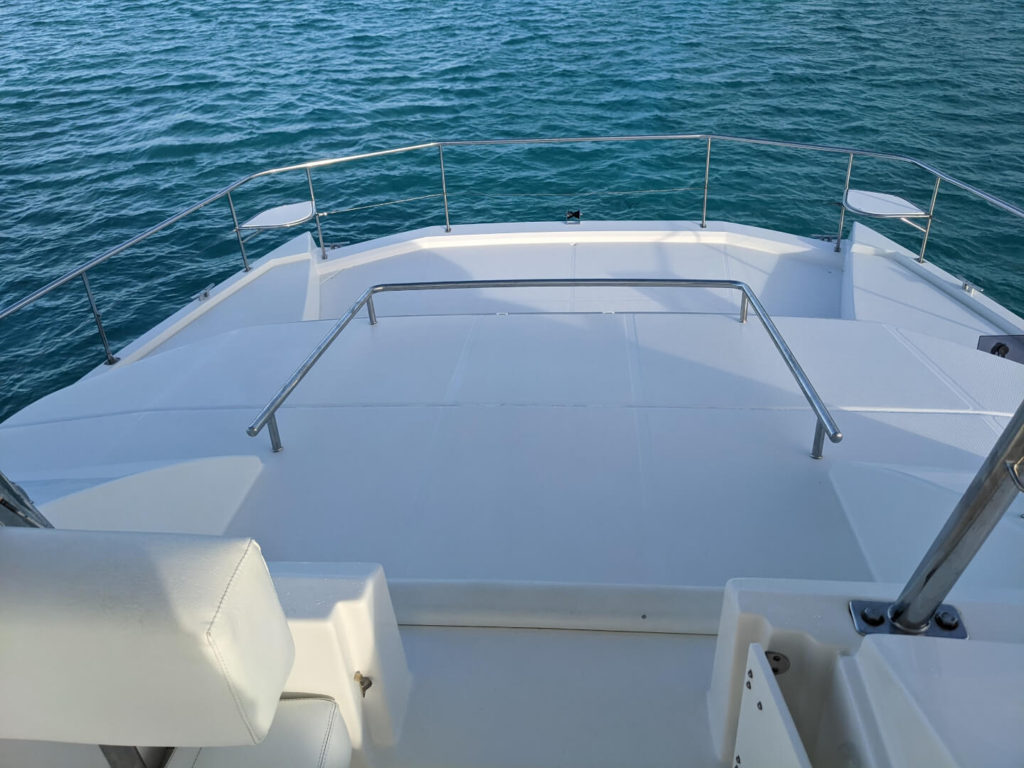
The settee cushions can all be lifted out to reveal an absolutely incredible amount of storage space. The gallon water jugs in the photos give some perspective as to the space. You could pack this with 60-70 gallons of water with space above the jugs for more. Similar storage is available below the helm seat, which we used to keep our charts, hats, and binoculars neat and dry…without the flybridge curtains, everything wanted to blow away.

Leopard 43 Powercat Bow Area

Many newer catamarans, especially power cats have eliminated the trampoline in favor of a full-length deck. The Leopard 43 Powercat follows this trend. There’s a lot of internet pontification about the dangers of stuffing the deck vs the benefits of riding the top of a wave. There’s also concerns about hull slap, which occurs when the wide deck between the catamaran pontoons gets banged by a wave. When we were in rough seas we got some very loud, crashing hull slap, but it was further aft under the salon where the trampoline wouldn’t have made a difference. We never stuffed the bow, so I can’t speak much to that, although in rough seas the fear or that giant deck going under a wave was very real.
We honestly didn’t spend much time on the bow or think much about it. However, I can’t help but think the kids would have loved laying on the trampoline and getting splashed like we did on our Lagoon 380 in the BVI .
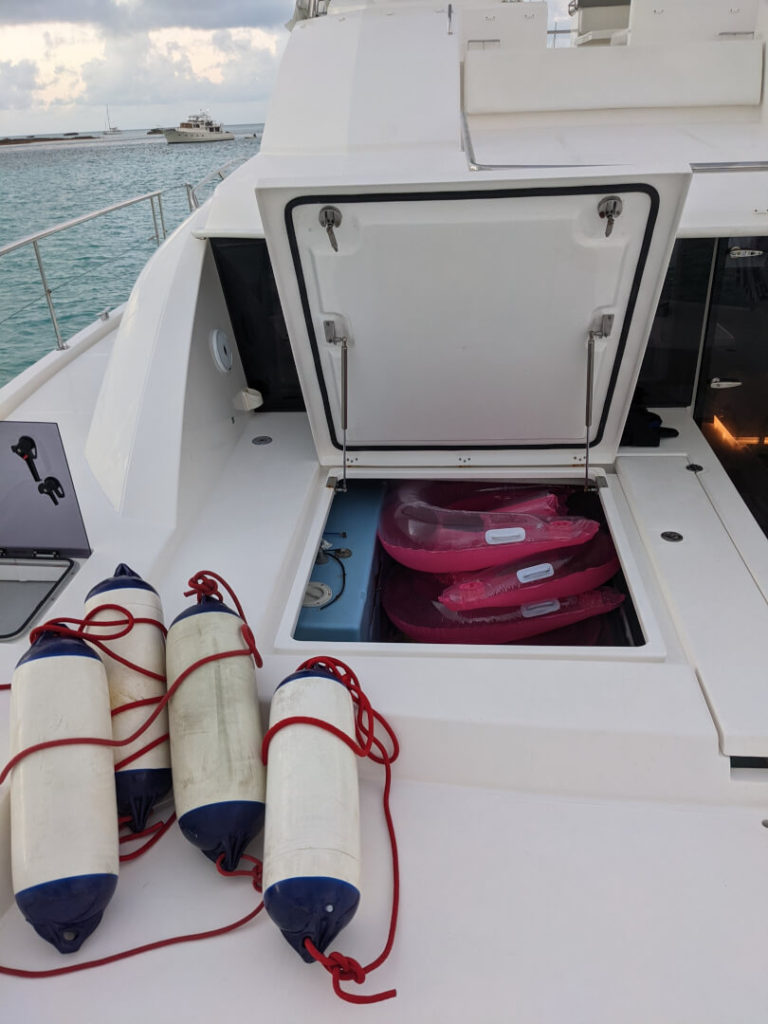
There was a HUGE storage locker in the deck that held the spare anchor, fenders, dock lines, and snorkel vests. This was a great place to throw wet toys and clothes while underway. We were able to store four large fully inflated floaties along with the secondary anchor and road, and four 8″ fenders with plenty of room for more. One of the two water tanks is located here; its translucent sides made it easy to confirm how much water remained. The other tank is is in a smaller locker on the opposite side of the steps.
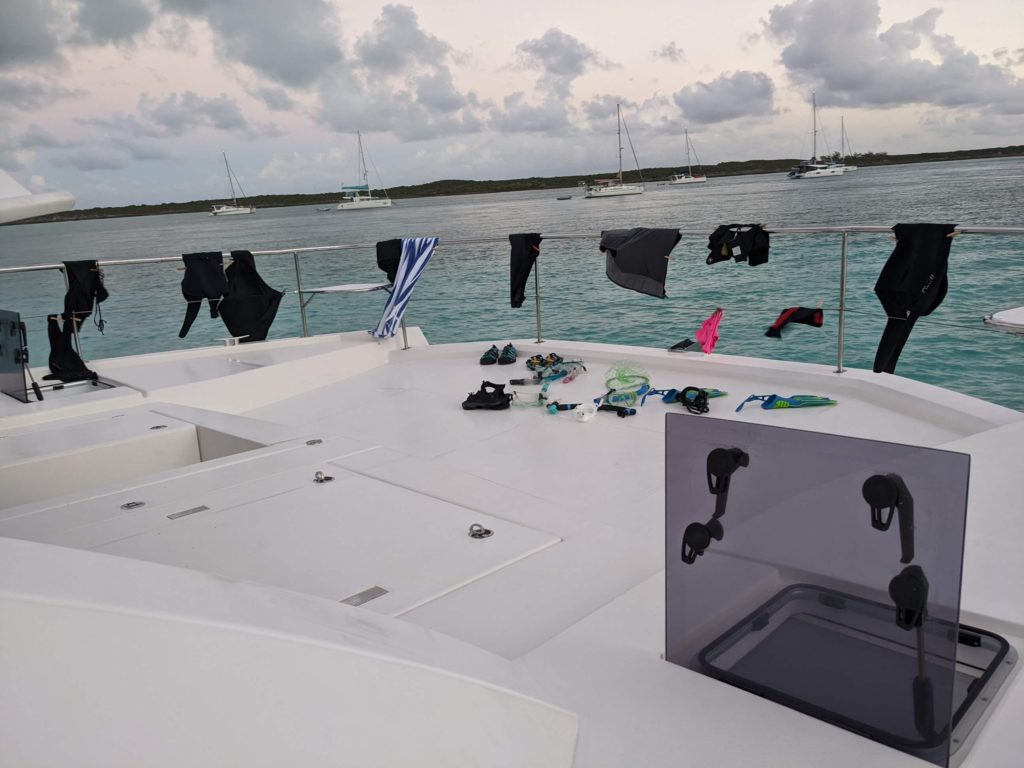
Leopard 43 Powercat Cockpit

The cockpit (rear seating area) on the Leopard 43 Powercat cockpit has yet another roomy U-shaped settee (couch) and dining table. This setting accommodates a larger crowd than the salon. The settee has fitted bottom cushions, but fiberglass backs. It is a bit easier to slide in and out of a crowded table because you can climb out onto the deck from the rear of the bench. The rearmost bench has a movable seatback that can be reversed; this allows your mates to sit facing the stern while at anchored.
The forward part of the bench can be lifted to reveal a large storage, along with the batteries. The rear bench holds the life raft and shorepower equipment on one side and a drained storage locker on the other. Our yacht had dinghy pump and inflatable life jackets stowed in the drained locker. This seemed logical, but the inflate handles on the jackets can get stuck in the large drain holes. When pulling the jackets out, one of them blew with my head in the locker…very startling!
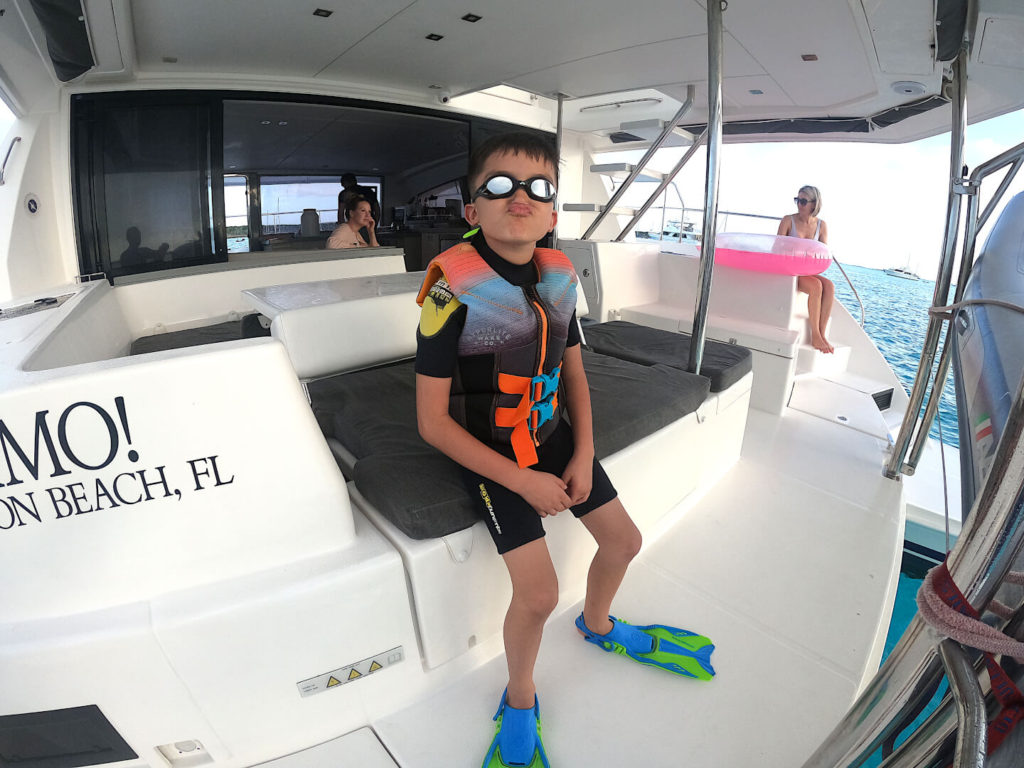
Another locker next to the life raft was used to store life jackets on our yacht; this locker has drains which is nice for this sort of thing, but the drains are large enough that one of the inflation handles got stuck and scared the shit out of me when I pulled it out and caused it to inflate with my head in the locker. Fortunately, there were a dozen or so rearming kits under the salon bench, so I was able to re-arm this one along with a few other vests that he been pre-inflated prior to us taking delivery of the yacht.
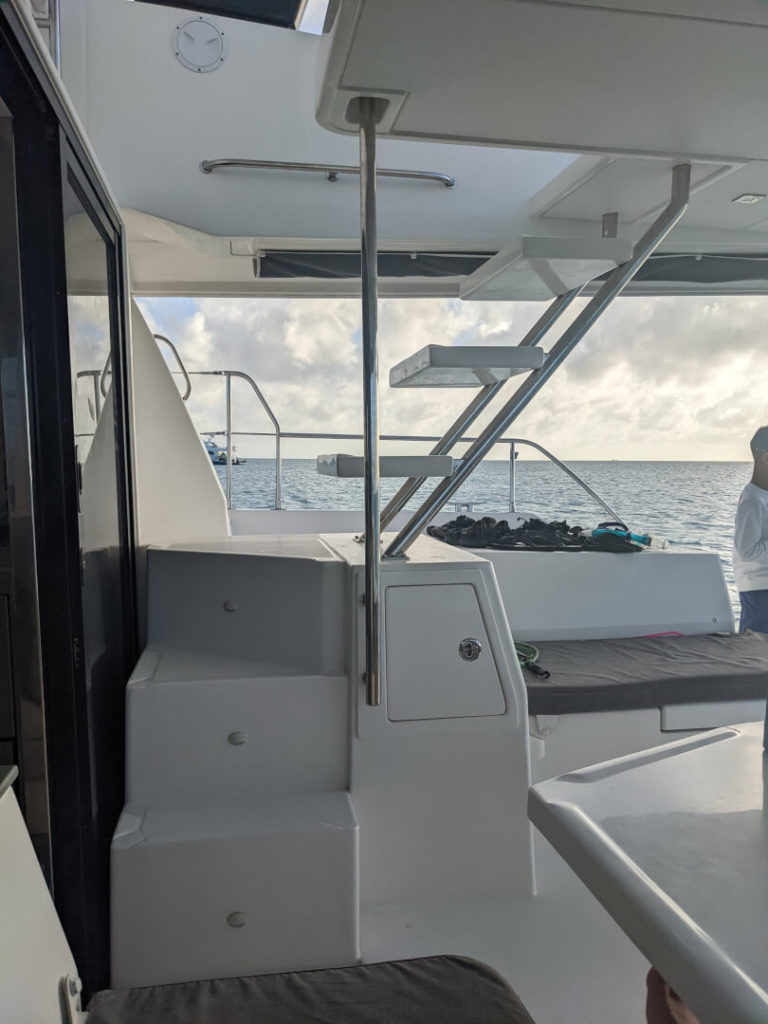
Opposite the settee you’ll find stairs leading to the flybridge. Under the stairs is a small bench that stores two propane tanks beneath.
The dinghy hangs from a davit between the hulls at the stern. An electric cable windlass is used to raise and lower it. In rough seas it can really get to swinging, so we used the dinghy painter (rope on the bow) to tie it more securely against the davit hardware. This is the most convenient dinghy stowage system that I’ve ever used.
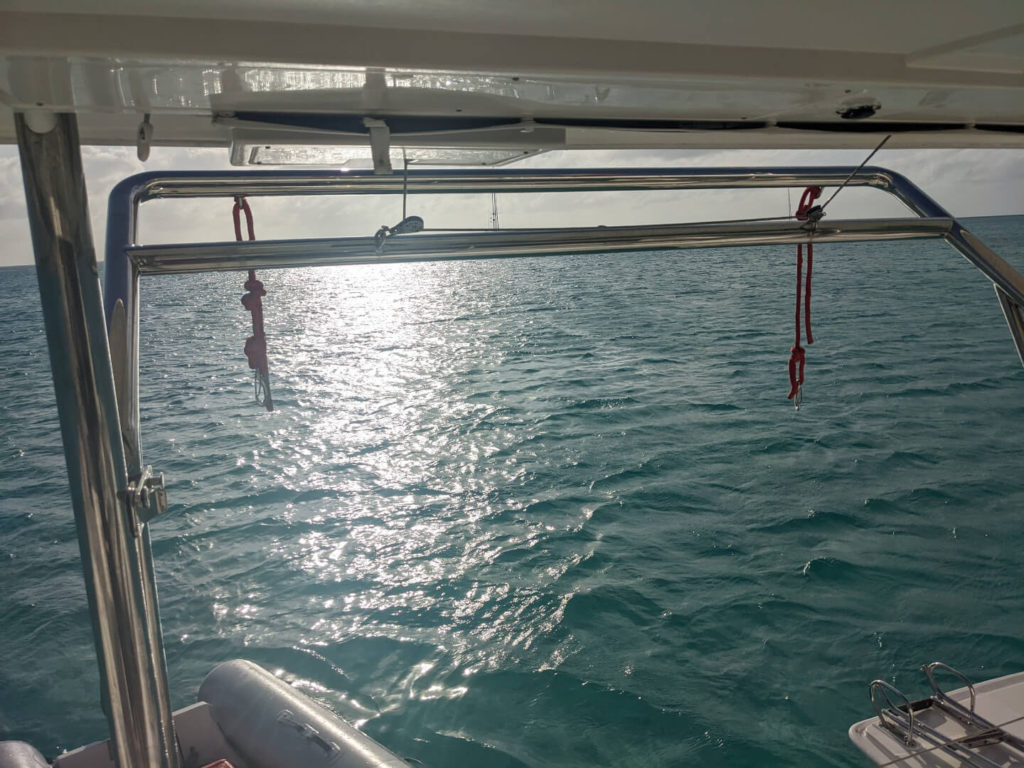
Stairs on either side of the stern lead down to a 3′ swim platform that makes up the Leopard 43 Powercat three feet longer than the Leopard 40 sailing cat. The swim platforms are welcome as they make it easier to board the dinghy. They also contribute to a straighter prop shaft that we discussed earlier, and likely help maintain a natural trim when running at higher speeds.

Half-way up the outboard side of the steps on either side is the diesel fill. These are positioned directly above the tanks so they are less likely to get backed up and barf petrochemicals all over your yacht and the sea. Nonetheless, its always helpful to have an idea of how much fuel you need and watch the meter so you can slow down when you think you are getting close. Our yacht did not come with oil absorbing diapers, which are nice to hold around the nozzle in case there’s a spill.
Below the steps on each stern, there was a ‘lazarette’ with even more huge storage areas. The starboard (right) side was wide open, while the hot water heater and generator were mounted in the port (left side).
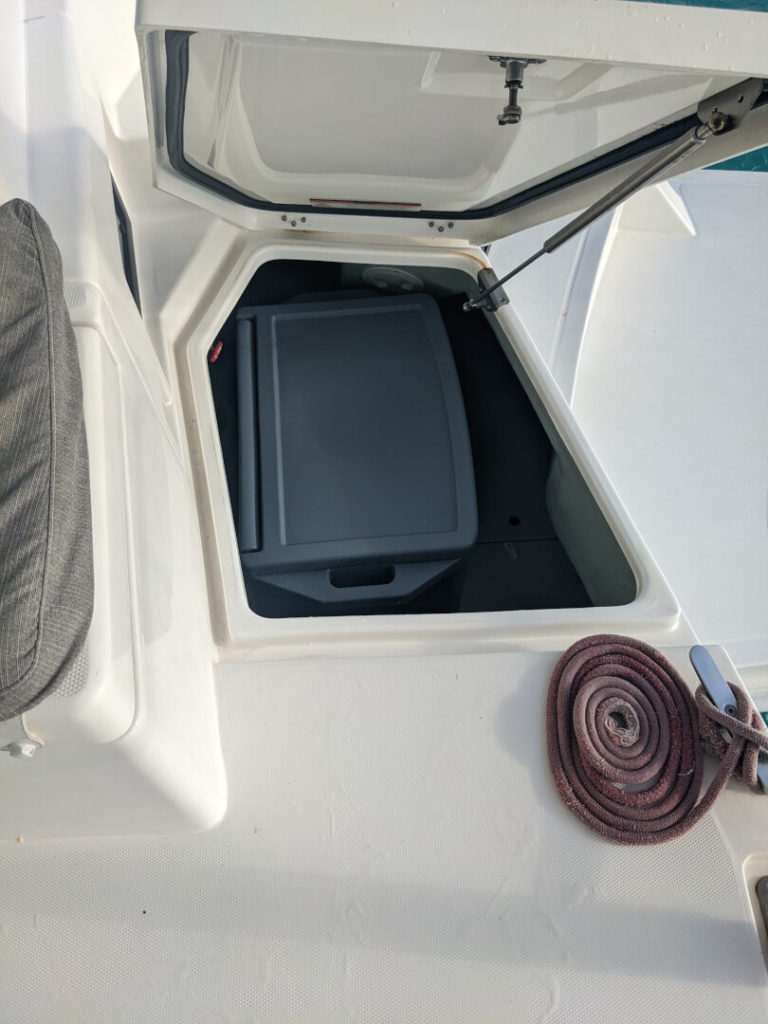
Leopard 43 Powercat Side Decks
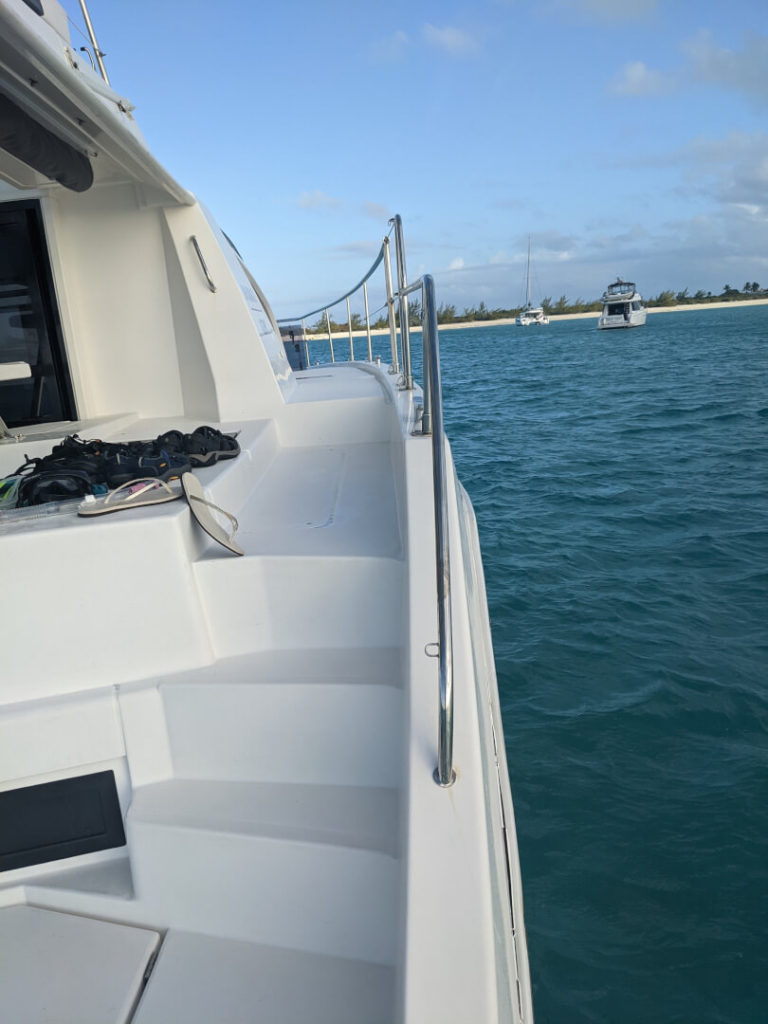
You will never fret getting from the stern to bow on the Leopard 43 Powercat. In addition to being able to walk through the salon, there are generous side decks wide enough to accommodate an above average American without shimying sideways. The decks are flat with solid full inch thick, tall stainless railings. This is a huge improvement over the tight, tilted gunwales protected by loose, low, frayed wire lifelines often found on sailing monohulls. We also found three very large and sturdy cleats along each side of the yacht capable of holding plenty of line for the most hamfisted of attempts to secure this thing to a dock.

The yacht comes equipped with mesh shades over the side windows that can be rolled up. We snapped them down before leaving port knowing that they would help keep the yacht cool. The snaps are these finicky little plastic things that require patience and world class dexterity to install. The same snaps also secured the cockpit cushions. If you needed justification to bring kids along on your voyage, this is it.
Salon on the Leopard 43 Powercat

Older cruising catamarans, and many performance-oriented catamarans, have a sloped salon roof making for a marginally useful area forward. However, the Leopard 43 Powercat has a full height salon with vertical windows forward and a door to access the bow. The door is a great way to allow open up a cross breeze while at anchor or on a buoy since you’ll have wind coming off the bow. Careful heading for the bow too quickly though, Abby the Giraffe bonked her head on the flybridge floor on her way up the steps…right in front of the checkout skipper, causing a commotion that certainly gave him pause. The door has a tight seal with three locks; there are two detents, allowing the door to be cracked for ventilation. Be sure to double check this is closed all the way before getting under way if you prefer your cabin dry.
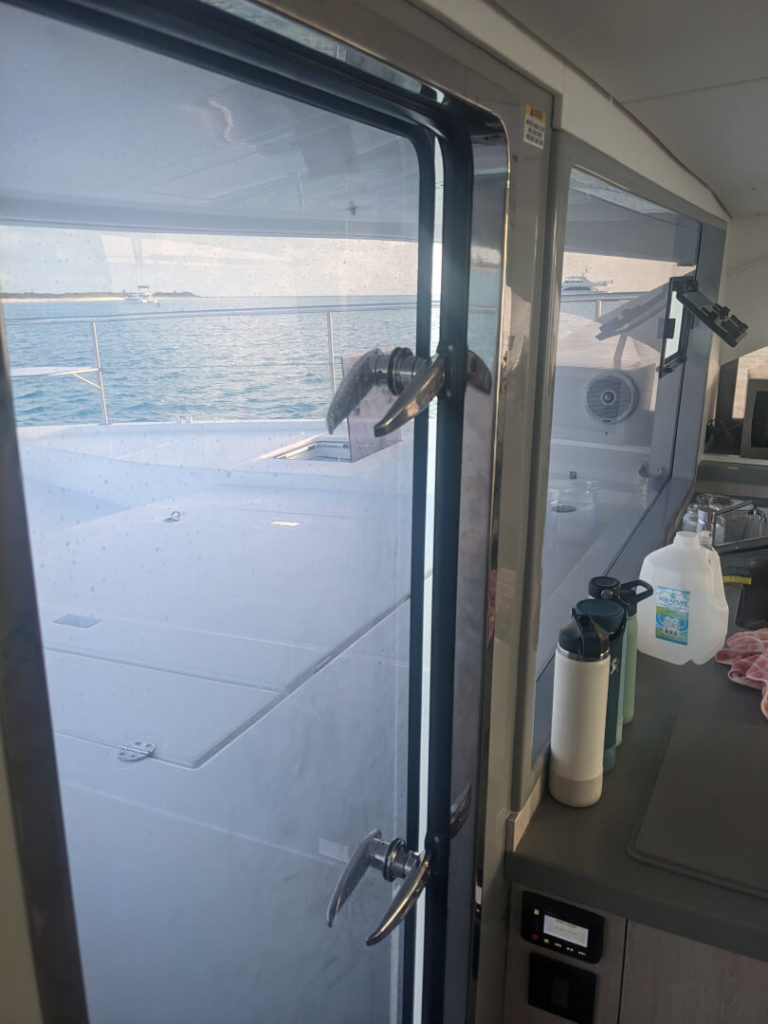
The salon has an L-shaped settee with a table that can be lowered to convert into a generously sized bed. Our 12 year-old slept here comfortably all week without ever executing the conversion. Getting in and out of the bench during dinner service can be a hassle. There are also two stools with storage underneath that can be set on the open side of the table to increase capacity or minimize in/out climbing. The windows between the salon and the cockpit slide open without any framing between that and the companionway door. This offers connection for crew sitting on either side, or just letting in a breeze.
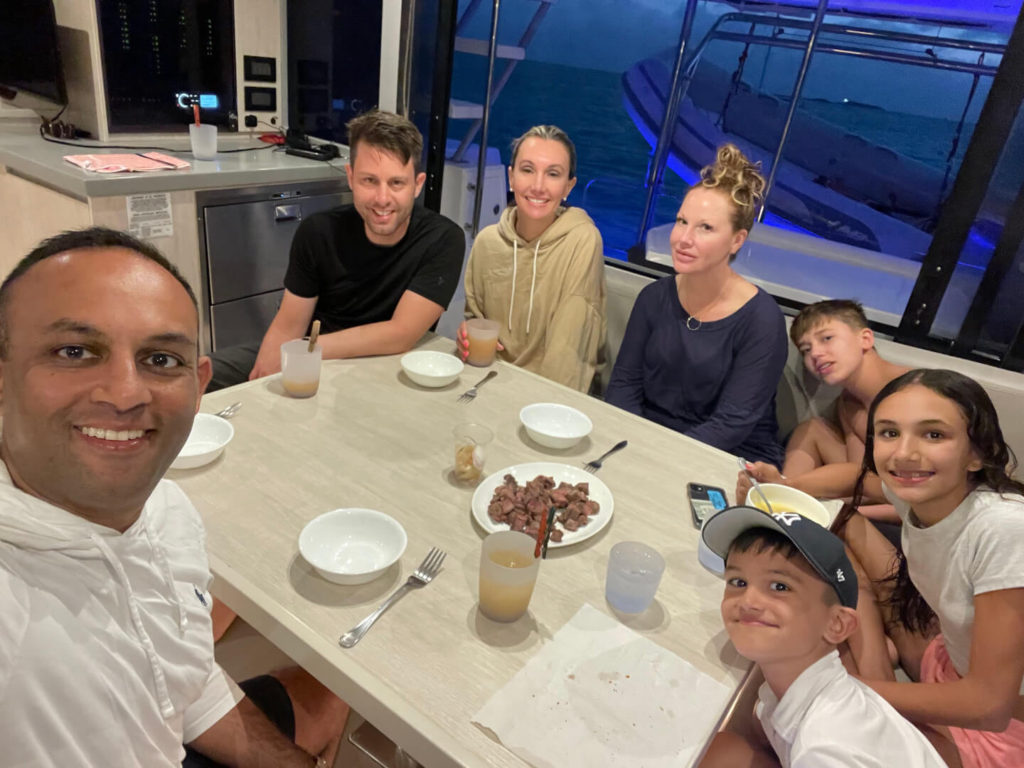
Across from the settee, next to the companionway door is the electrical panel. Behind the glass door, in addition to the circuit breakers is the controls for the air conditioner, watermaker (if equipped), VHF, generator, and stereo. Remote stereo controls are also mounted on the flybridge and next to the forward salon door so you don’t have to dive in there to tinker…although you’ll probably use blueteeth to run tunes from your phone and only need to access the volume settings after the initial paring, which was easy…don’t forget to download a solid playlist before leaving home in case you have limited internet access on your voyage.

In the final corner of the salon area, forward/starboard, there’s a navigation table with storage below. There’s also a deep long ledge over the living space below that’s great for holding random crap like binoculars, eyeglasses, and water bottles and for charging phones and cameras. There is a set USB and 120v outlets here as well as next to the electrical panel. The USB outlets work without the genset, the 120v do not as the yacht is not equipped with an inverter. With the helm on the flybridge, it isn’t easy to go back and forth to check charts while under way.
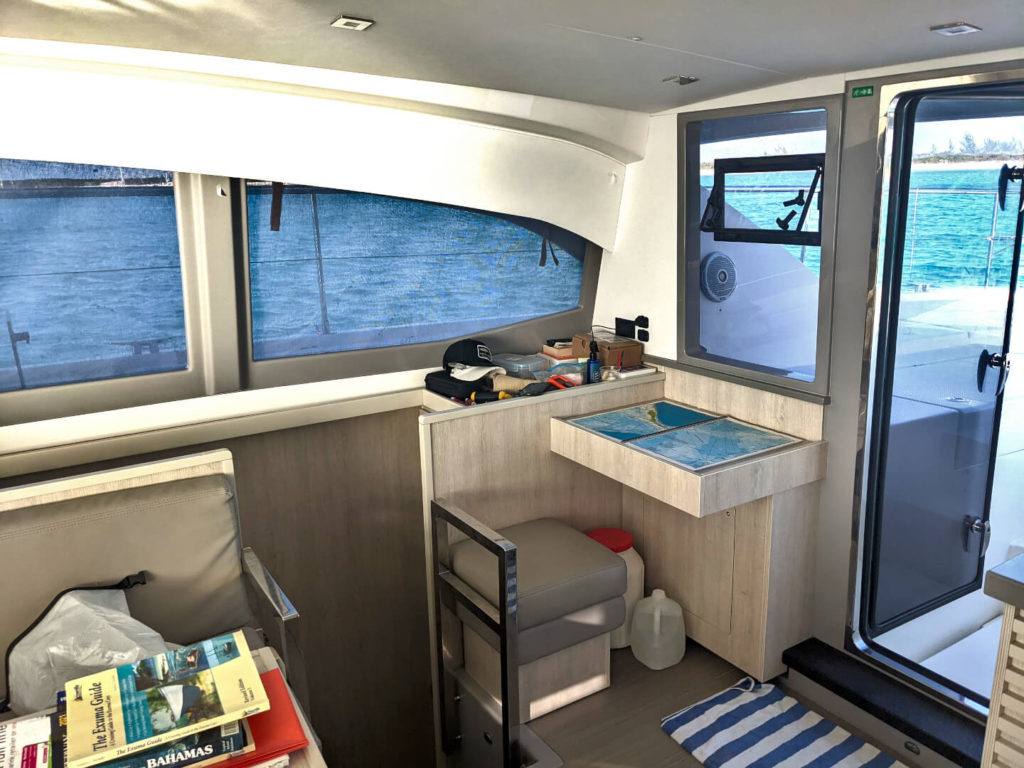
Living Quarters on the Leopard 43 Powercat
The Leopard 43 Powercat comes in two floorplans: the 433 PC is a three stateroom, sometimes called an owner’s layout, as well as a four-stateroom plan, called the 434 PC. The port (left) hull of the 433 has two staterooms fore and aft with a head (bathroom) in between. The starboard (right) hull of the 433 is configured as an “owner’s suite” with a bed at the stern, a larger bathroom forward, and a ‘get ready’ area in the center. In the 434, both hulls are equipped like the port hull in the 433PC, making a four stateroom, two head layout.
Port Living Quarters
When choosing the forward vs aft cabins, each has their advantages. The aft stateroom has a bed with full width end to end and a generous closet. Slightly smaller than a queen mattress, there was ample room for two adults, even if its too hot to get cozy. With the engine beneath the bed and the generator behind the bed, if you aren’t the first to wake up each morning, you’ll be the second.

The forward stateroom has a bed that tapers toward the bow, making it a bit smaller in total. It also has a smaller closet than the aft stateroom. However, it also has an open forepeak area at the foot of the bed that can be used for storage or sleeping small/medium children. The lack of engine beneath the bed here allows two drawers beneath the bunk too.
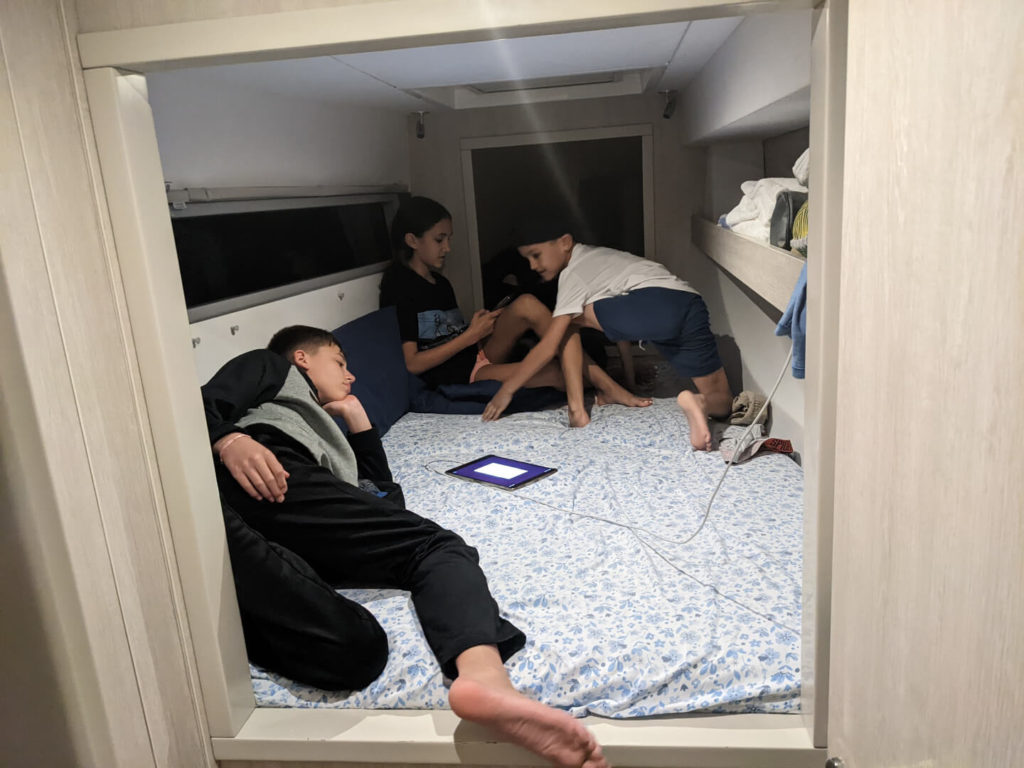
Both staterooms have two shelves that run alongside the bed. They are wide enough to stow emptyish duffle bags, breakables, and charge phones on the well-located USB sockets. Both have locking doors and air conditioning supply ducts. They also both have hatches overhead and to the side, with a fan mounted in front of the side hatch. The aft stateroom has a third hatch at the rear. All overhead hatches have a retractable blackout cover and bug screen. All but one of our hatches still had them entirely intact. The side windows have curtains to cover them. One side window on our yacht was cracked.
Port Head (Bathroom)
The port head (bathroom) has a toilet at one end, a vanity in the center, and a shower with a porthole at the opposite end. There is also a hatch with a screen and shade on the ceiling. A small wastebasket folds out of the vanity where we were instructed to place our buttwipes rather than flushing them since the base does not provide RV toilet paper. There are several hooks for towels and wet clothes. (note that what you hang in the head will smell like the head…raw sewage in our case) All materials are waterproof except maybe the wood veneer pocket door opposite the vanity…that said, the pocket door is a nice touch given the tight space.
The shower comes close to having a true stall but has a flat floor and lacks a door or curtain to enclose it; but at least you don’t have to stand in the shower while using the toilet. The shower wand is height adjustable and removable. The water control is a single lever that turns for temp and pulls for pressure. This makes it easy to pause without resetting the temperature control when taking a navy shower. The drain pump operates automatically as the shower drain fills with water (as long as it is switched on at the breaker panel in the salon). There are several hooks throughout for towels and wet clothes and a ledge with railing in the shower for soaps and bathing supplies. All in all this is a very adequate, if not excellent head for a yacht this size.

Owners Suite
In the Moorings/Leopard 433 PC, the starboard (right) hull houses the “owner’s suite”. The suite includes a bed in the stern that matches the other hull, a long hallway in the center with lots of storage and a desk/vanity, then a large head at the forward end of the hull.

Instead of having a door to the bedroom, there’s a huge sliding piece of wood that closes off the hallway from the salon at the stairs to make one large room. We found two downsides to this design:
- First, opening the slider makes the area very open, so if one person needs to go in and out of the area while their partner is buck naked getting dressed, it’s hard to find a private place to stand while the door is open.
- The other issue is that the air conditioning is far less effective in this layout. The two air conditioning supplies, as well as the return, are all located in the hallway, creating a large space to be conditioned…furthermore, we were trying to cool the bedrooms while leaving all the exterior doors open to the salon. Every time you go in and out of that huge door, you let all the cold air out in this scenario. Aside from that, it is a pretty trick design.
The stern bed on the owner’s side matches the one on the port side.
Owner’s Head (Bathroom)

You’ll think the port head is great until you see the master head on the starboard side. Located in the bow, it has a very generous, fully enclosed shower stall. Even more generous storage in and around the vanity. There are lots of bars and hooks for drying. There’s also a huge cabinet forward of the shower where the V-berth is in the other hull. You can fill that sucker up with anything that can tolerate the bathroom humidity. We used it to store some more rigid bags and boxes, but barely put a dent in the space. The toilet is mounted in the corner behind the swinging door. This allows for plenty of knee room when you need a bit more purchase to get the job done. The fixtures and pumps are the same as the other head, but the hatch is much larger in here.
There’s a 120v outlet at the desk/vanity that can be used to blow dry and curl your hair with the generator on. Note that this outlet is on the galley circuit, so it will conflict with any appliance you might be running at the same time, such as the coffee maker.
Systems on the Leopard 43 Powercat
Air conditioning.

There are two separate air conditioning units that supply each hull and can be set to different temperatures. The port hull has one supply vent in each stateroom and a third in the salon, with the return air in the hallway. The starboard hull (owner’s side) has a supply vent at each end of the hallway, one in the salon and the return air in the hallway. On the port hull, the supply vents are located inside the staterooms.
Closing the stateroom doors on the port hull cooled those small areas very quickly. The large cooling area in the starboard hull, on the other hand, took longer to cool down and gave up its cooling quickly when sliding the giant door open if the yacht wasn’t completely closed. So, the system was most effective with the salon doors closed and cooling the entire yacht. Not a bad thing as some catamarans only have capacity to cool the staterooms. The air conditioners also have a dehumidify setting and can be run in reverse cycle to heat the cabin. You must run the generator or be on shore power to operate the air conditioners.
The yacht is equipped with a 9 KW Northern Lights diesel generator. There is no inverter on these yachts, so any 120v application requires that the generator be running. This includes the a/c, watermaker, flybridge BBQ, kitchen appliances, water heater and 120v outlets. The generator isn’t disruptively loud, but it does rock the yacht a bit when starting; my crew appreciated a warning before firing it up. In cruising service, our yacht had twice as many hours on the genset as the engines. I would welcome an inverter to reduce fuel consumption and running hours when only a light load is needed. However, in charter service, this is likely to result in more severe experience for the batteries.
The fridges, pumps, and navigation equipment all run on 12 volts, allowing them to run off the batteries. With help of the solar panels and regular use of the generator, our checkout skipper said we shouldn’t need to worry about state of charge on batteries. However, we did get a low house battery warning on the Raymarine MFD on our 6th day away from shore power.
The anchor windlass and dinghy davit are both 12 volt, but have a big draw. So, like on most yachts, you should have an engine running to ensure adequate voltage for the motors and reduce wear on the batteries. In the case of the Leopard 43, the port engine carries the charging load and is the one to run.
Our yacht came equipped with a watermaker. Watermakers use a large pump to press saltwater through a high density filter, removing the salt. This process requires a lot of electricity, so the generator must be on to use it. Out islands in the Bahamas use the same type of reverse osmosis systems to make water on shore. Because of this the water hose at the fuel dock is not free. Rather it costs 40 cents or more per gallon, making the generator operation economical, even at $5 per gallon for diesel. However, our checkout skipper spent 20 mins or so tinkering with it and couldn’t get it started. Watermakers are notoriously finicky, so this was not a surprise. The watermaker is located underneath the forward port bed.
The Leopard 43 Powercat comes with two 102-gallon water tanks and two 12-gallon hot water heaters. While the hot water heaters serve each side separately, the freshwater tanks serve the entire yacht and can be switched open separately. This allows you to open one tank at a time, so if you’ve got an overzealous showerer on your crew, they can’t tap both tanks in one shot; giving you an extra day to re-water. With four adults and three kids aboard for a week we refilled the primary water tank after the second morning and did not empty it entirely before returning the yacht. So the total capacity for both tanks would have been sufficient for the week. However, the kids mostly bathed in the ocean and just rinsed off with the fresh-water pump on the stern.
The supply water pump was located in the salon and very quiet, so you won’t wake the crew while washing your hands in the middle of the night. The water heaters were very effective in that we had hot water in the morning before turning on the generator and we never ran out. The automatic shower drains were nice (compared to manual drains), but they were not silent.
The yacht comes equipped with Jabsco electric heads. The Jabsco head is operated with sea water, with one button to fill the bowl before you do your business, and another button to suck it into the holding tank. Most charter yachts, well most yachts under 100 feet, are equipped with a similar system. While a manual pump is very common, electric pumps like this one is considered an upgrade. The electric pump makes it easier to go potty and to rinse the toilet, but might result in filling the holding tanks faster. It’s also harder to rinse the valves with the electric system (read on).
Using sea water for flushing reduces fresh-water consumption. However, that short cut has an unfortunate side effect: the saltwater reacts with your piss to crystalize into a stinky mess. The crystalized saltwater piss builds up on the toilet valves so that, over time, they don’t close. It also builds up in the hoses (making it easier to clog) and in the holding tank (reducing your capacity). Somehow, this cocktail also manages to leech through the hoses and stink up the bilge. If this type of system isn’t serviced after each week of use, this science experiment compounds, leaving the yacht with a perpetual sewage smell and a system that hesitates to accept and contain your waste…like on our yacht.
Like RVs, these systems clog easily, especially with toilet paper. Moorings has charterers supply their own toilet paper and instructs us to put the TP in the wastebasket…not only a hard reflex to overcome, but gross. It would seem more effective for the charter company to supply the yachts with sufficient RV toilet paper, which is what we see when chartering in the Pacific Northwest.

On our yacht, the port tank was full on the first night and clogged intermittently throughout the trip. The starboard head constantly leeched a stream of piss onto the bathroom floor. At one point we got an airlock on the starboard head and it wouldn’t fill the bowl with water. I was able to fix it by closing the seacock, removing and draining the filter, then putting it all back together. Then we only got 3 days out of the starboard head after emptying…then two days. Be sure to empty your tanks every chance you get.
When we returned our yacht to Moorings with a long list of safety issues, they didn’t have much of a sense of urgency, but once the dockhands got word that we had a clogged head, they were down there in a heartbeat. Apparently, the Nassau base policy is that charterers pay $100 cash to whomever unclogs the head. We refused to pay given the issues we had.
If you do get a yacht with a crystalized valve, you can put some vinegar in the bowl and ease a small amount of it into the drain system with a partial flush (easier to do with a manual pump than the electric)…I learned that after returning home from this trip.
Anchor Windlass
Our anchor windlass worked as expected. It is noteworthy in how easy it was to access. The windlass is located in a hatch next to the stairs outside the forward salon door. The remote is stored in this locker with a cable long enough to be walked to the edge of the bow while watching the anchor rode. From these locations it is very easy to look up and speak to the helmsperson on the flybridge.
An anchor bridle spans between the hulls beneath the bow to secure the anchor rode once the anchor is out. You can’t see much of it from the topside of the yacht, so it could be a bit confusing the first time you use it if you don’t have much experience with catamarans. There are no length markings on the anchor rode, so how much you let out will be a total guess. On the bright side, we set the anchor at least a dozen times and never had the chain bind in the windlass or need to fiddle in the chain locker.
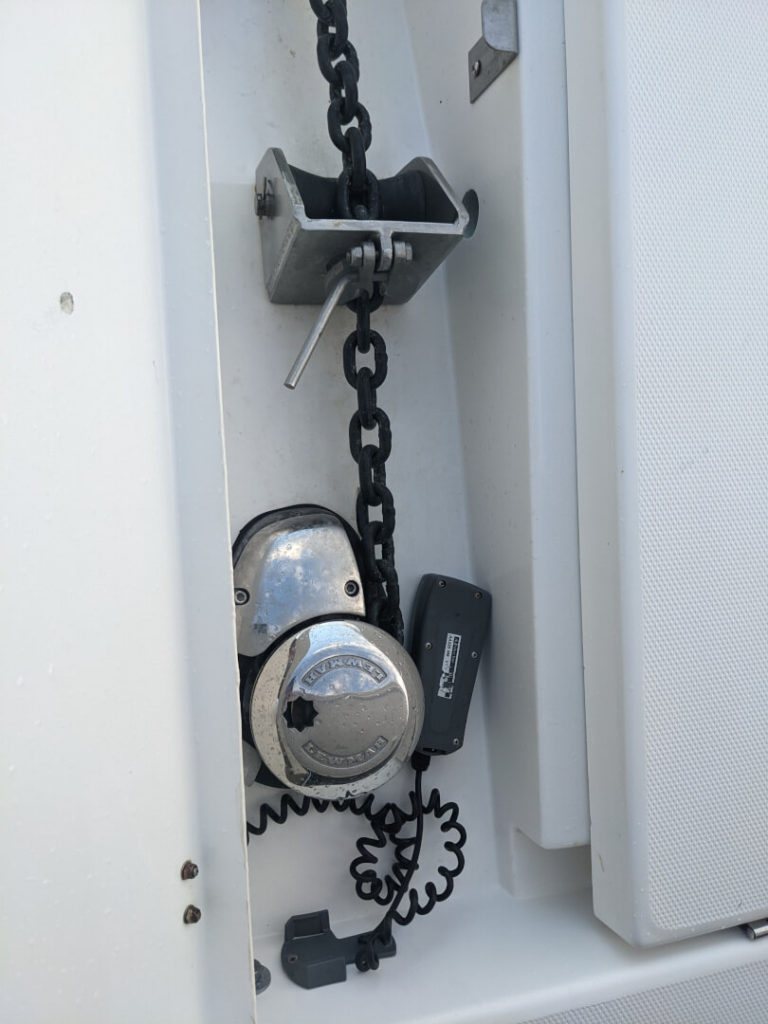
Because the anchor and windlass are mounted 15 or so feet behind the end of the bow, you have to drop the anchor at the windlass, then run up to the edge of the bow to watch while you let chain out, then run back to the windlass compartment to attach the bridle once the anchor is set. From these locations it is very easy to look up and speak to the helmsperson on the flybridge.
Our primary anchor was a big bitchin Delta anchor that dug in real nice. Even when the tide turned in some very shallow water and left us 90 degrees off our original position, the flat, low, wide shank dug into the sand and refused to drag.
Lighting on the Leopard 43 Powercat
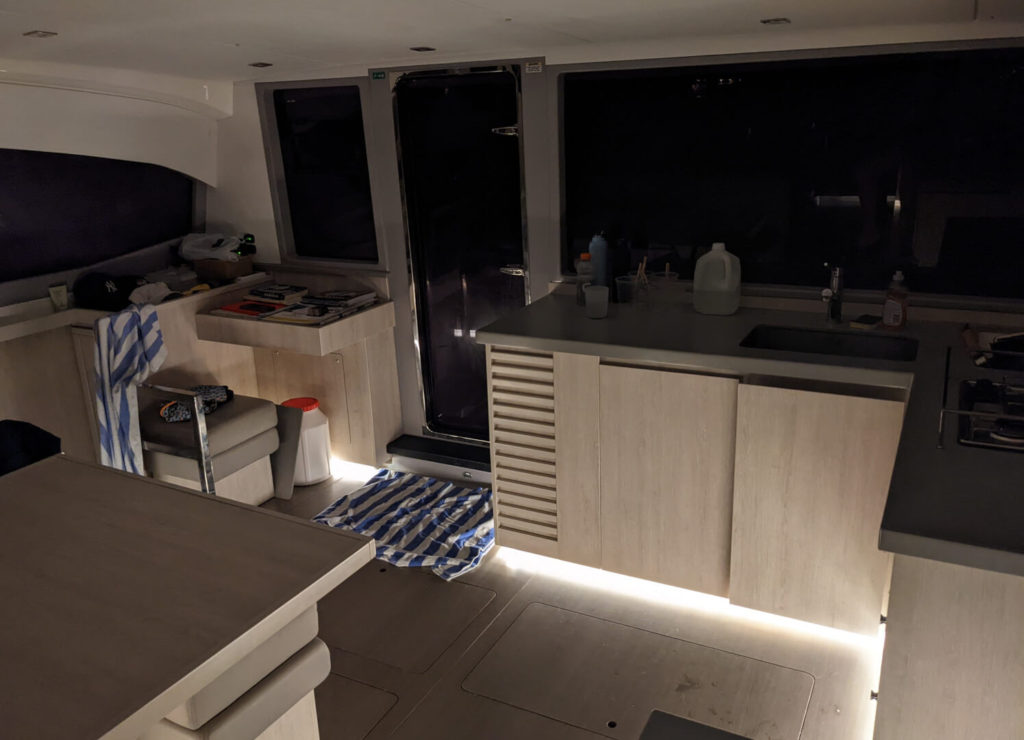
The Leopard 43 Powercat comes with lots of lights to ensure adequate lighting under many circumstances. The light switches were in logical locations mostly worked logically. The salon had three levels of lights, including a set of rope lights under the cabinets. It unfortunately did not have a low nightlight to allow some visibility while kids are sleeping on the settee. The flybridge also had under cabinet rope lights, white lights on the roof, and red lights for use while running at night. However, it did not have running lights to look forward (while in rental service, you aren’t supposed to run at night anyway).
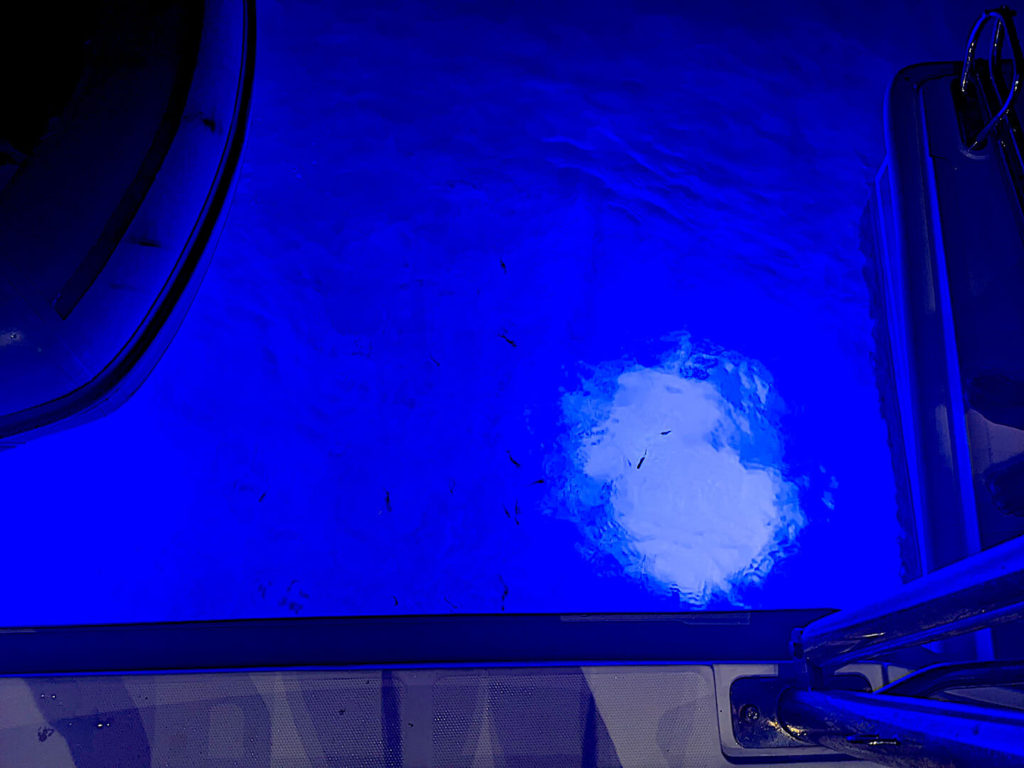
The yach had a set of blue underwater lights that made it easier to find the yacht when approaching with the dinghy at night. It also made for some cool views of the fish after dark and made it easy to confirm our running gear was in good order after we drug anchor and were not sure if we’d run aground. It also ensured we were visible while anchored after our anchor light fell over.
Problems with the Leopard 43 Powercat
Our Leopard 43 Powercat presented a surprising amount of problems on our weeklong bareboat charter. Especially considering our yacht was just over three years old at the time. I’ve already shared the problems we had with the heads, VHF, flybridge enclosure, anchor light, toaster, microwave, propane valve, inflatable life vests, both refrigerators, and the watermaker. So, I won’t repeat them here.
Unfortunately, this doesn’t seem to be an isolated issue. I spoke with a charterer before our trip that had recently gone out in an even newer yacht. He had problems with throttles, gauges, navigation, air conditioning, and the watermaker. I also spoke to the maintenance manager at the base. He acknowledged that the fleet was not being maintained as well as it should be and noted that he was recently hired to help the team start digging out, but was running into challenges.
After I reached out to The Moorings three times over 5 months, they responded with an apology and a credit for $1,304 towards our next charter, valid for three years. They did not offer an explanation or note whether conditions in Nassau have improved. In their defense, I think their customer service team got slammed dealing with other issues in the British Virgin Islands . I reached out to their press team for an update on these issues, but have not received a response.
The Moorings set us up with a sweet dinghy on our charter. It was a 10-foot RIB with a 25-horsepower motor. While it was rated for 5, we had plenty of room (and didn’t sink) with a crew of 7 and were still able to kick up a wake. While a 10-horsepower motor is more common on dinghies of this size, the transom was rated for 25 and it really did get us to shore nice and quick.
One day when I was in the dinghy alone, going into a bit of wind, I throttled up and the bow came a at least 5 feet out of the water, almost flipping the boat end over end! One disappointment that’s common outside the US is that it was a two-stroke engine. Two-strokes, if you don’t know, lose some unburned gasoline in the exhaust and ultimately into the water; they’re also less efficient and stinky. Worse yet, ours wasn’t delivered with a full fuel tank, so we had to fill it during our cruise and buy a full quart of two stroke oil (for $20!) to make the fuel mix.
The dinghy came equipped with a folding grappling anchor on a floating line (behind a bit of chain). While grappling anchors fold down nice and compact for storage, they really need rocks to bite, so it was useless at holding us in the sandy bottoms of the Bahamas. Additionally, the shackle pin was not installed tightly and fell out while we were using it.
If your itinerary includes regular use of a dinghy, (if you are anchoring or using mooring balls, it does), having a dinghy davit is a #GameChanger. Without a davit, you have to tow your dinghy. That means you’ve gotta remember to pull it in and keep the painter out of the prop while docking, and possibly remove the outboard while underway. Not docking? You’ll still need to bail the water out of it after towing. The Leopard 43 Powercat has a davit on the stern that makes it a cinch to launch and retreive the dinghy.
Bareboat Charter Equipment from The Moorings
The Moorings equipped our charter yacht with a strong supplies list. The kitchen was well stocked with storage and mixing bowls, plenty of cups, plates, bowls and cutlery for a crew of eight or more.
Navigational manuals included the top guides for our cruising grounds in the Exuma Cays: Explorer Charts and Pavalidis’ The Exumas Guide . The binoculars on the other hand were hilariously worthless. They were marked as 7×50 (meaning 7x magnification) with no brand name and weighted almost nothing. However, I don’t think they were even 2x magnification. Fortunately, we brought our own 7×50 binoculars which not only served to confirm there was something wrong with these, but allowed us to use binoculars, you know, when we needed them.
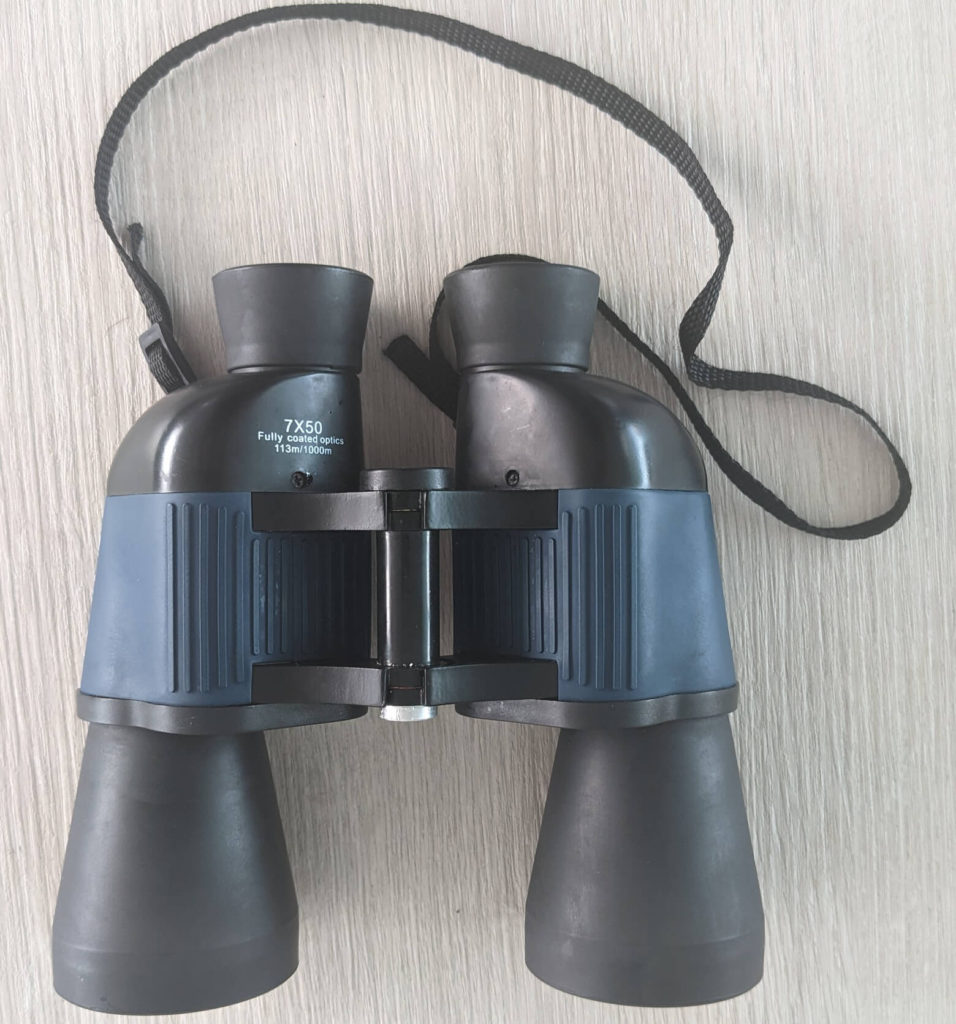
A full kit of inflatable life jackets was a welcome luxury compared to many charters with gross, old, ill fitting life jackets. However, as we learned, don’t trust a borrowed inflatable until you’ve verified that it is properly armed. Our yacht came with twice as many rearm kits as lifejackets, as well as safety harnesses beneath the salon settee. There was also a set of snorkel vests in the bow, which provided an extra level of safety when we ventured out with dive weights on. Snorkel vests are uninflated vests that you can self inflate if you run into trouble by blowing into a straw.
The toolkit consisted of two spare impellers (that we were told not to try to replace oursleves), spare fuses, spare hose clamps, a can of WD-40, a huge flathead screwdriver, phillips screwdriver, one allen wrench, and channel locks. Fortunately, we didn’t need it.
A plastic dry bin for the dinghy held some flares, and a flashlight.
Aside from the weak toolkit and lack of any working VHF, the other piece of kit we really would have liked to have was a broom and dustpan, or vacuum. The floors got pretty gross with a week of tracking sand through the yacht.
Features to Look For in a Leopard 43 Powercat
Options on the Leopard 43 Powercat are relatively limited, and when chartering from The Moorings, you from the fleet, not a specific named yacht. Your only choice is age. That said, the optional flybridge refrigerator makes for more food storage, which allows for more thorough provisioning up front. Depending on cruising grounds, this can save money and stress…or just eliminate the need to scurry down to the salon for bevvies while under way. The larger engines that our yacht was equipped with probably run a bit faster and eek out a few extra MPGs. Unfortunately, its a roll of the dice as to whether you’ll have these features on your charter.
The optional watermaker didn’t work on our charter, which is not surprising for watermakers. However, we would have welcomed it given the cost of water in the Exumas. In most cruising areas with access to water, it won’t be worth the fuel to operate a watermaker…and they don’t make water fast enough to take longer showers, so don’t think that’s an option!
How Much Does a Leopard 43 Powercat Cost and Where Can I Rent One
The shallow 3’1″ foot draft of this yacht allowed us to run up and down the shallow banks of the Bahamas’ Exuma Cays and anchor in some tight bays with confidence. These yachts are also available in The US and British Virgin Islands, Greece, The Seychelles, and Saint Lucia.
As of this writing, there are some dates available to charter the four stateroom 344 PC for as low as $3,700 of the three stateroom 433 PC for $3,900. At the other end of the spectrum, there are spring dates in Nassau currently listed for as much as $16,000. These yachts are also available in The US and British Virgin Islands, Greece, The Seychelles, and Saint Lucia.
Alternatives to the Leopard 43 Power Catamaran
If you like the general design of the Leopard 43 Powercat, but want to sail. The Leopard 40 will scratch that itch for 25-25% less in charter fees ($1k-$4k). Leopard has discontinued these models in favor of the Leopard 42 [sail] and (in 2023) the Leopard 42 Powercat. The new 42s have twin heads on the guest stateroom hull that likely comes at the expense of storage and the forepeak berth. Expect Moorings to keep the old models in bareboat charter for another five years while they’re slowly phased out in favor of the new models.
If you are looking to double down on the condo-cat vibe and rent something a bit more pontoony , Marine Max runs a charter fleet in the British Virgin Islands that is right up your alley. The 443 has a full beam owners suite and three heads with fully enclosed showers.
How Much Experience Do You Need to Rent a Leopard 43 Powercat
The good news is you don’t need any sailing experience to rent a powercat. However, your charter company will probably want you to have twin engine experience. Our checkout skipper did not expect us to be able to dock the yacht or maneuver within the tight Palm Cay marina. Depending on your comfort level, the checkout skipper can tow an extra dinghy out of the marina and use that to get back after setting you off; call the base and they’ll do the same in reverse. In addition to twin engine experience, you’ll need to be comfortable operating a similarly sized yacht (The Moorings will say +/- 5 feet) and have experience with the challenges of the particular cruising area you’ll be in.
A good friend of mine says sailing is about the journey, and powerboating is about the destination. My Spring Break Busy Boater crew was east bound and down: a long way to go and a short time to get there. The Exuma Cays were filled with cool stuff we wanted to see and do during the one week we had, and the powerboat speed was the insurance policy to get it done.
The generous storage, tankage, and electrical systems neutralized the lack of infrastructure for fueling, watering, docking, and provisioning in the Exumas. The vast living space on the Leopard 43 Powercat ensured that two families with three children ended the trip as friends. As long as we stayed on the calm West side of the Exuma Cays where our condo-cat was comfortable and forgot about the pee smell and lack of ability to call for help, the whole crew enjoyed the great weather and beauty of this unique part of the world.
However, I can’t ignore the fact that we missed out on the opportunity to hoist the sails in one of the most idyllic sailing destinations in the world with strong trade winds crossing calm, protected waters. The powerboat speed also comes at a price premium of $1k-$4k in additional weekly charter fees and, for the distances in the Exumas at $5/gallon, $700-$1,000 in additional fuel for the week, depending on how much sailing you missed out on.
CatamaranReviews.com
Leopard catamarans.
Leopard got it’s start in 1994 when South African boat builder Roberts and Caine partnered with charter company, The Moorings to build charter catamarans. Due to the popularity and durability of the catamarans built by Roberts and Caine, the Leopard Catamaran brand was formed in 2000. Leopard Catamarans builds spacious and durable cruising catamarans that are ready for coastal and offshore sailing. More than 1,000+ Leopard Catamarans have been built and used around the world in The Moorings, Sunsail and Footlooses extensive charter fleet. Prices for a Leopard Catamaran vary from $150+ for a used Leopard 38 to 1.5M+ for a Leopard 58. For prices of a new Leopard please contact Leopard Catamarans or an authorized Leopard dealer.
Leopard Models
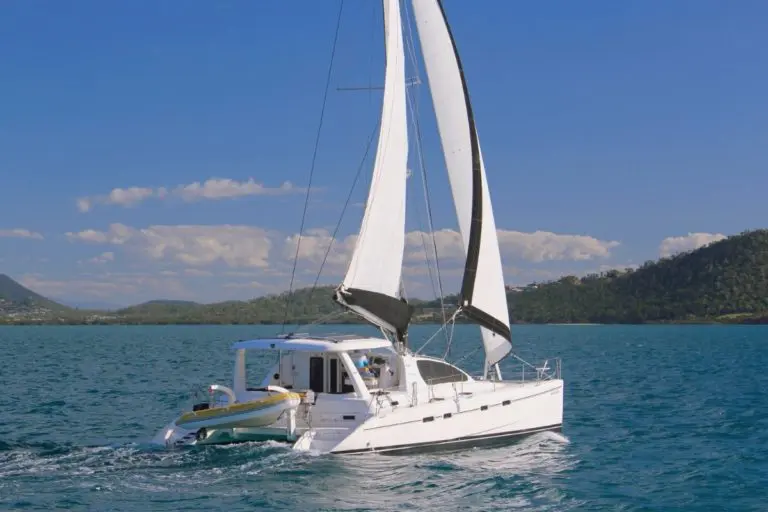
The Leopard 43 is a popular cruising catamaran. The well thought out, comfortable design, and ability to sail short-handed makes an ideal blue-water cruising boat. Built with a high standard of construction, they are good value for money on the used catamaran market. DESIGN – INTERIOR & EXTERIOR The Leopard 43 is a comfortable and reasonably fast passage maker able to be sailed short-handed. Based on the award-winning Leopard 42, the Leopard 43 is designed by Simonis and Voegd and built by Robertson and Caine, a large South African builder. These catamarans were built in two configurations, one for owners and one for the charter market. The owner’s version, called the Leopard 43 has three cabins and three heads. While
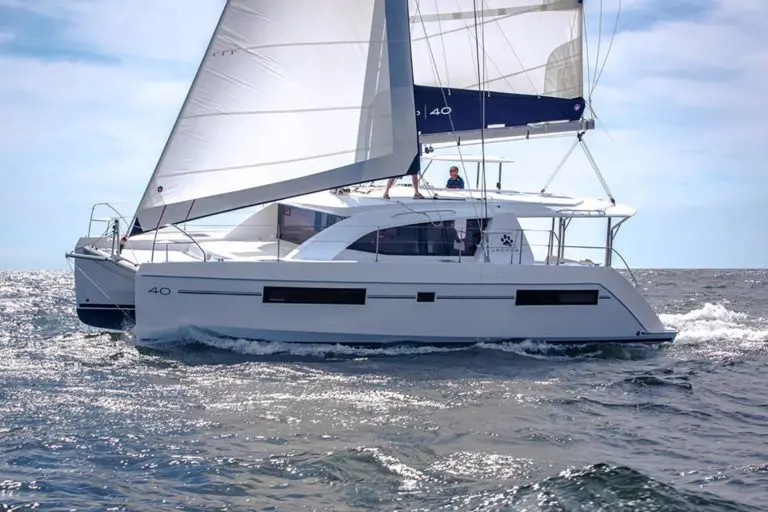
The recently redesigned Leopard 40 sports an increased interior volume and modern interior layout. A unique saloon to bow access door gives easy access for sunbathing and chilling out on the deck. With a bright and uncluttered design and a helm with excellent visibility, the Leopard 40 provides the safety expected for the bluewater lifestyle in a comfortable package. DESIGN – INTERIOR & EXTERIOR Designed and built by South African firm Robertson & Caine and along with Naval Architects Simonis-Voogd, the Leopard 40 attempts to set a new standard for cruising catamarans. Based on customer and owner feedback, the most recent Leopard 40 has a redesigned configuration. As an evolution of the Leopard 39 design, the increase in hull volume,
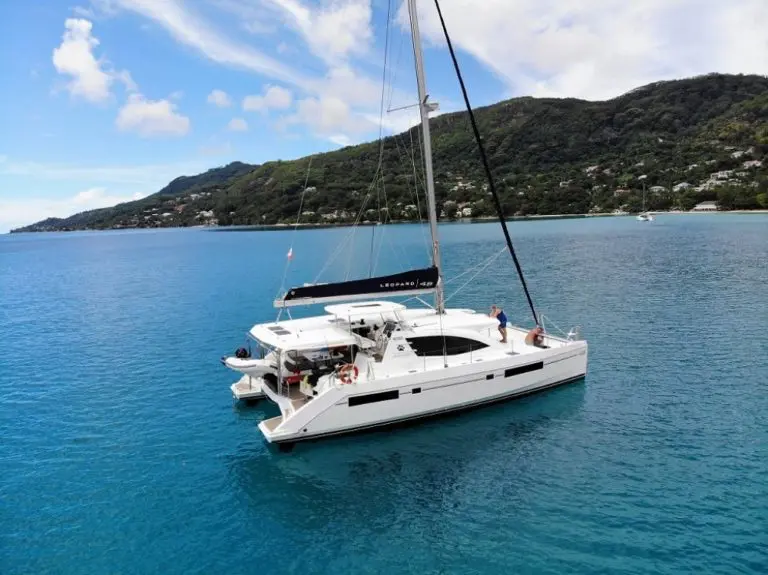
Winning the Boat of the Year Award in 2013, the Leopard 48 set new standards for cruising catamarans by not only offering a large floor plan but also twin cockpits with its sleek design. By launching the Leopard 48 in replacement of its most successful 46-footer, the catamaran company incorporated the feedback received from yacht sailors and paid close attention to improve the seaworthiness of the vessel. DESIGN – EXTERIOR & INTERIOR The Leopard 48 catamaran is a product of South African builder Robertson and Caine and naval architects Alex Simonis and Voogd. DECK Boarding the Leopard 48 from the wide transom platform is easy and comfortable. First witnessed in the Leopard 44, the twin cockpits of the Leopard 48
Catamaran Makes
New reviews, most popular.
- Mediterranean
- South Pacific & Oceania
- South-East Asia
- Indian Ocean
- Northern Europe
- Bareboat Monohulls
- Bareboat Motor Yachts
- Bareboat Catamarans
- Crewed Yachts
- How our services work
- Multi-Database Searching
- Boat Charter Price Guidelines
- Free Charter Guide
- About Sail Connections
- Client Charter Reviews
Specifications
Leopard 43 - bareboat catamarans.
The Leopard 43 is a good all-round charter catamaran, with four double cabins and forepeak singles for children through a door at the foot of the double bed. This boat's release introduced many new features that have since been adopted by others of similar size. Good for groups of eight who can happily fit into a 43ft catamaran.
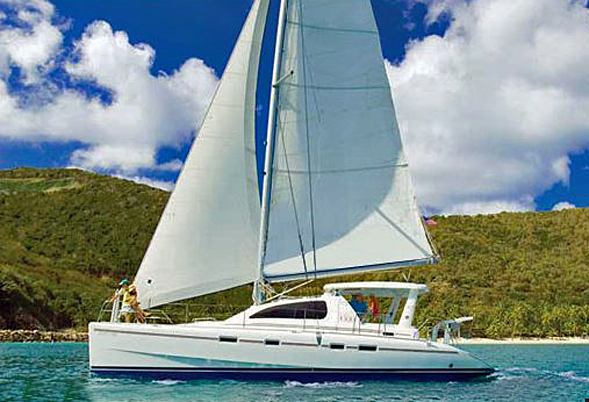
Date Added: Nov 11th, 2018 Last Updated: Mar 29th, 2023
Charter Locations
- Regions: Caribbean , Mediterranean , South Pacific/Oceania
- Destinations: Antigua & Barbuda , British Virgin Islands , Croatia , Martinique, St Lucia, & The Grenadines , Tahiti: The Society Islands , Turkey
- Guests: 8 to 10
- Cabins: 4 double + 2 bow single
- Length: 13.1m, 43'
- Beam: 7.0m, 23'
- Draft: 1.3m, 4'
- Engine(s): 2 x 39hp
- Fuel Capacity: 360l, 95g
- Water Capacity: 780l, 206g
Equipment Includes: Standard Equipment: bimini /spray hood, electric windlass, h & C water, transom shower, 12 volt electrics, dinghy and outboard, bed linen, VHF, CD/FM radio. Additional equipment may vary. Ask us for equipment available on this boat in your preferred destination.
Yacht Layout
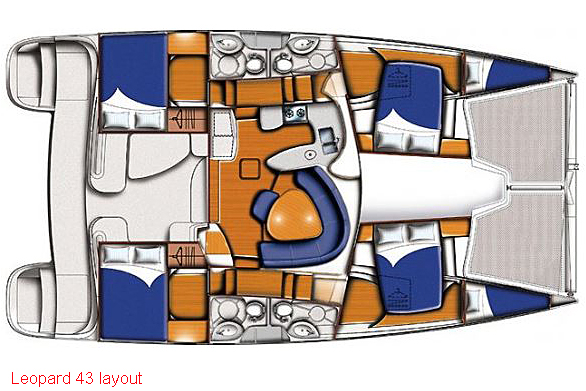
Specifications and accommodation layouts may vary. Ask us for the details of this boat in your preferred destination. Many boats have additional saloon berths not indicated above.
The Sail Connections Guarantee
One contact - every option - advice you can trust.
- Matching any competitive offer
- Sourcing boats with discounts available
- Personalising our proposal just for you
- Qualifying the operator as well as the boat
- Advising without bias based on 25+ years of experience
- We do more than just book yachts!
We will match any discount website offer on charter boat price, and still provide our customary high level of service.
The Essential Guide to Sailing Holiday Charters
The Sail Connections Essential Guide to Bareboat and Crewed Sailing Holiday Charters is jam-packed full of useful tips for getting the most out of your next boat charter. And it is FREE to download.
Enquire about a charter...
For a personal proposal structured to meet your needs, with advice on all aspects of your sailing charter.
- European Union
- South Africa
BoatTest - Leopard 43 PC
Did You Know That We Offer Contract to Closing Services? Click Here to Find Out More.
Need Marine Financing? Apply Here With Our Partner, First Approval Source
- Catamaran Interviews
- Catamaran Reviews
- Buying Advice
- Selling Advice
- Woods Design Advice
- Americat 3014
- Balance 526
- Bali 40 Catspace
- Beneteau Blue II
- Broadblue 346
- Broadblue 38 Prestige
- Broadblue 385
- Broadblue 435
- Broadblue 46
- Catalac 10M
- Catalac 11M
- Catalac 12M
- Catalac 900
- Catana 42 S
- Chris White 48 Voyager
- Chris White 55
- Corsair F28 R
- De Villiers
- Dolphin 460
- Endeavour 30
- Endeavour 35 Victory
- Endeavour 36
- Endeavour 44
- Endeavour 44 TrawlerCat
- Fortuna 36 Island Spirit
- Fortuna 401 Island Spirit
- FP 32 Maldives
- FP 35 Tobago
- FP 37 Antigua
- FP 38 Athena
- FP 39 Fidji
- FP 40 Lavezzi
- FP 40 Lucia
- FP 40 Summerland MY
- FP 41 Lipari
- FP 42 Astrea
- FP 42 Venezia
- FP 43 Belize
- FP 44 Helia
- FP 44 Orana
- FP 46 Bahia
- FP 46 Casamance
- FP 48 Salina
- FP 56 Marquises
- FP 57 Sanya
- FP 60 Eleuthera
- FP Saona 47
- Gemini 3000
- Gemini 3200
- Gemini 3400
- Grainger 420 Mystery Cove
- Hirondelle 7M
- Lagoon 37 TPI
- Lagoon 42 TPI
- Lagoon 43 PC
- Leopard 39 PowerCat
- Leopard 45 Classic
- Leopard 47 PowerCat
- Leopard 51 PowerCat
- Leopard 53 PowerCat
- Maine Cat 30
- Maine Cat 41
- Matrix 450 Vision
- Matrix 760 Silhouette
- Maverick 400
- Maverick 420
- Maverick 440
- Nautitech 40
- Nautitech 442
- Nautitech 46 Open
- Nautitech 47
- Outremer 40
- Outremer 45
- Outremer 50 Standard
- Outremer 55
- Privilege 37
- Privilege 39
- Privilege 42
- Privilege 43
- Privilege 435
- Privilege 45
- Privilege 465
- Privilege 48 Transcat
- Privilege 482
- Privilege Serie 5
- Prout 31 Quest
- Prout 33 Quest
- Prout 34 Event
- Prout 35 Snowgoose
- Prout 37 Snowgoose
- Prout 37 Snowgoose Elite
- Prout 38 Manta
- Prout 39 Escale
- Royal Cape 45
- Royal Cape 530 Majestic
- Royal Cape Majestic 500
- Sailcraft 30 Iroquois
- Sailcraft 32 Comanche
- Sailcraft 35 Cherokee
- Sailcraft 41 Apache
- Sailcraft 44 Apache
- Wildcat 350
- Seawind 1000
- Seawind 1160
- Seawind 1200
- Seawind 1260
- Seawind 1600
- Solaris 36 Sunrise
- Solaris 36 Sunstar
- St Francis 44
- St Francis 48
- St Francis 50
- Stealth 11.8
- Heavenly Twins 26
- Ocean Twins 38
- Voyage 380 Maxim
- Voyage 400 Norseman
- Voyage 430 Norseman
- Voyage 450 Cabriolet
- Voyage 47 Mayotte
- Wharram 38 Tiki
- AMI 320 Renaissance
- Woods 22 Wizard
- Woods 35 Banshee
- Woods 35 Flica
- Woods 36 Scylla
- Woods 36 Vardo
- Woods 38 Transit
- Woods 40 Meander
- Xquisite X5
- Xquisite X5+
Brand: Leopard 43

The Leopard 43 is based on the award-winning Leopard 42 design, of which over 45 have been introduced since 2001. Features include a hard-top bimini, a longer transom, fixed stainless steel davits and twin Volvo 29Hp naturally aspirated engines. The 3-cabin layout features an owner-dedicated starboard hull, spacious double cabins with en suite heads and separate showers Electric Head (port). Fully equipped galley and expanded saloon with breakfast bar. A clear deck layout, excellent bunk access, walkthrough access from the cockpit to the aft swim platform and a galley-up design are popular features with cruisers.
There are no catamarans currently for sale by owner of this brand.
Please see our catamarans for sale by owner page for a full listing of other currently available models.

IMAGES
VIDEO
COMMENTS
The market price of the Leopard 43 is in the range from $275,000 to $375,000 depending on the condition and version. CONCLUSION. Overall, the Leopard 43 is a thoughtfully designed catamaran, and the ability to sail short-handed makes it an ideal blue-water cruising boat.
The Leopard 43 is built in a balsa/glass/polyester sandwich. Only the deck-hull joins, the chines and the skeg keels are in monolithic. The deck/hull connections are glued, bolted, and laminated at strategic points. The bulkheads are glued to the hulls. The core is made of balsa, chosen over foam because of its resistance.
Power Catamarans like the Leopard 39, 43, and 53 are mid-sized catamarans featuring the stepped hull design. This allows for more accommodation space without decreased yacht performance, tremendous speeds -up to 24 knots ( 44.4km/hr) - and outstanding fuel efficiency.
The four double cabins aboard our test version are very comfortable and spacious… and the finishing is excellent! With its well-balanced hulls, the Léopard 43 is capable of respectable averages, in excellent comfort. A catamaran designed for cruising in warm seas…. The only fault; the Léopard slams in rough seas….
January 16, 2017. Power catamarans like the new Leopard 43 pc are a fast-growing segment of the boating market. Combining speed, fuel-efficiency, comfort, and easy handling, there's much to like—but I wanted proof. So, eschewing the usual single-day boat test, I chartered a Moorings 433 (a Leopard 43 pc with three cabins) for a full week in ...
It takes into consideration "reported" sail area, displacement and length at waterline. The higher the number the faster speed prediction for the boat. A cat with a number 0.6 is likely to sail 6kts in 10kts wind, a cat with a number of 0.7 is likely to sail at 7kts in 10kts wind. KSP = (Lwl*SA÷D)^0.5*0.5
Sailing with his wife and five kids ages 6 to 18 on a Leopard 43. Sailing out of San Diego and preparing to head offshore. Tusitala is the nickname of author Robert Louis Stevenson and means "teller of tales.". Chose Leopard 43 because of space and affordability. He considered monohulls but accommodations were smaller and did not like heeling.
Leopard 44. This midsize model from Leopard joins the multihull fleet. "Boat Review" from our December 2011 issue. South African catamaran builder Robertson and Caine and veteran multihull designers Morrelli & Melvin teamed up once again to produce the new Leopard 44, which is also available for charter as the Sunsail 444.
The Leopard 43 PC is an evolution of the breed, ... In 2000, the Leopard brand sail cats started. Leopard built its first power catamaran in 2007, the 47PC, and quickly followed with the 37PC. ... Leopard Catamarans and the Moorings are both owned by Travelopia, which is owned by global investment firm KKR.
Boat Review: Leopard 42. Sticking with its proven design formula, but also cherry-picking popular features from its recent models, Leopard Catamarans has launched a "best of" package with this new boat that sold nearly 30 units before hull #1 even touched water. Like a greatest hits album, the Leopard 42 combines the best of its 40ft and ...
The beam of the Leopard 43 Powercat measures twenty-two feet and one inch. The LWL is forty feet and ten inches. The draft is three-foot and one inch and the LOA is forty-two feet and eight inches. The Leopard PC 43 uses 2 two hundred twenty horsepower motors to power itself through the water. The fuel tank can hold two hundred sixty-four gallons.
The Leopard 42 comes in two layouts: a three-cabin owner's version with the master suite encompassing the entire starboard hull, and four cabins and four heads which will be popular in charter. Our test boat was laid out as the owner's version with a cabin that has few intrusive supporting structures.
Multihulls World Review - Leopard 43PC. Language English Boat: Leopard 43 Powercat. Cover Image: PDF: mhw-L43PC.pdf. Web Link: Original Article. Have a question about an option? Call us at 954-925-8050 . ... Leopard Catamarans. 311 Park Place Blvd, Suite 250, Clearwater, Florida 33759
A wholesale update of the 39PC, the new Leopard 43PC proves itself as one of the best small power catamarans on the water. The Leopard 43PC is an updated version of the 39PC, though it is an update far more comprehensive than a quick facelift and some new engines. No, from the hulls upwards the 43PC is different to its predecessor and had been ...
Nonetheless, many Dolphins have performed successful circumnavigations and have proven to be safe and comfortable cruising platforms. LOA 41ft 3in, beam 23ft, draft 3ft 3in/6ft 6in, displacement 24,255lb (loaded). Price guide: $220,000-$350,000. Privilege builds high-end boats and the 435 is no exception.
Alternatives to the Leopard 43 Power Catamaran. If you like the general design of the Leopard 43 Powercat, but want to sail. The Leopard 40 will scratch that itch for 25-25% less in charter fees ($1k-$4k). Leopard has discontinued these models in favor of the Leopard 42 [sail] and (in 2023) the Leopard 42 Powercat.
LEOpARD 43 pC T he predecessor to the Leopard 43 PC is a boat that I know well. I have chartered a 39 PC both in Europe and the United States, and have used the boat for week-long stints with a full compliment of guests on board to test its layout to the limit. The 39 PC was very good at it what it did, which was provide wipe-clean practicality for
The Leopard 43 is a popular cruising catamaran. The well thought out, comfortable design, and ability to sail short-handed makes an ideal blue-water cruising boat. Built with a high standard of construction, they are good value for money on the used catamaran market. DESIGN - INTERIOR & EXTERIOR The Leopard 43 is a comfortable and reasonably ...
The Leopard 43 is a good all-round charter catamaran, with four double cabins and forepeak singles for children through a door at the foot of the double bed. This boat's release introduced many new features that have since been adopted by others of similar size. Good for groups of eight who can happily fit into a 43ft catamaran.
Leopard 40 PC Power Catamaran Review. ... Leopard 43 pc/Moorings 433 Power Catamaran Review. Zuzana Prochazka. January 16, 2017. Boat Reviews. Leopard 40: Spacious Sailing, Catamaran Style. Zuzana Prochazka. March 25, 2015. Boat Reviews. Leopard 40 Sailing Catamaran Video: First Look. Lenny Rudow. April 6, 2015. Boat Reviews.
Polar diagrams show the Leopard 39 making 7.7 knots in 10 knots of wind on the beam. In 14 knots of wind, she increases to 9.7 knots with winds at the same angle. Heading downwind, she performs best at 135-150 degrees on a broad reach. In 12 knots of wind the vessel will move at over 8 knots. Spacious, Warm Interiors.
BoatTest - Leopard 43 PC. Language English Boat: Leopard 43 Powercat. Cover Image: Web Link: BoatTest Review Leopard 43 Powercat. Have a question about an option? Call us at 954-925-8050 . Get in Touch. Contact Us; eNews sign-up; ... Leopard Catamarans. 311 Park Place Blvd, Suite 250, Clearwater, Florida 33759 ...
Displacement: 19,030 lbs/8,845kg. Mast Height: 63ft / 19.20M. Mfg Engines: Yanmar 3-cyl 3JH4 30hp diesel engines x 2. Mfg Accommodations: The Leopard 4300 is a blue water capable vessel that sleeps up to 10 persons in 4 staterooms and forward hull berths. The hulls are mirror images of the other, having two staterooms with queen berths and two ...